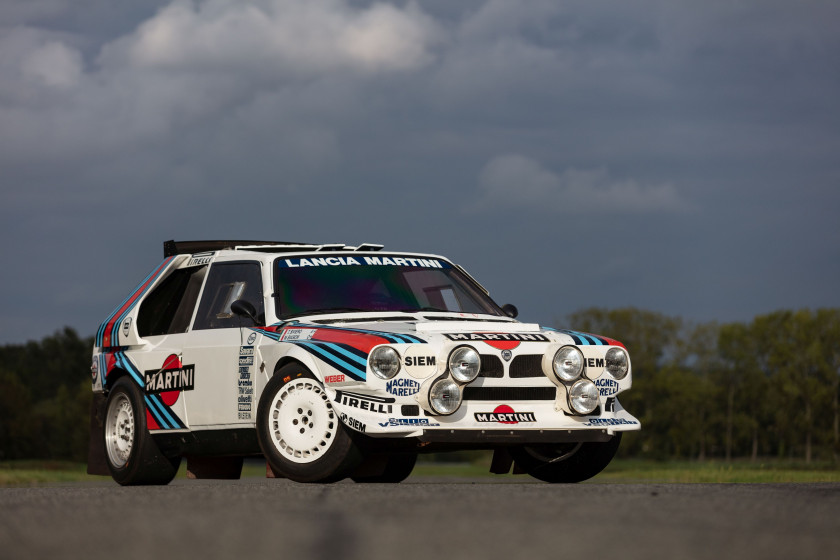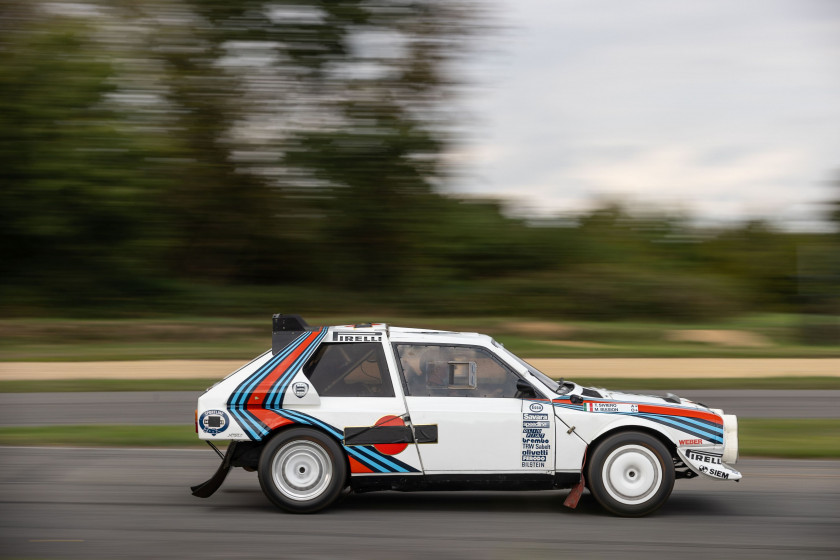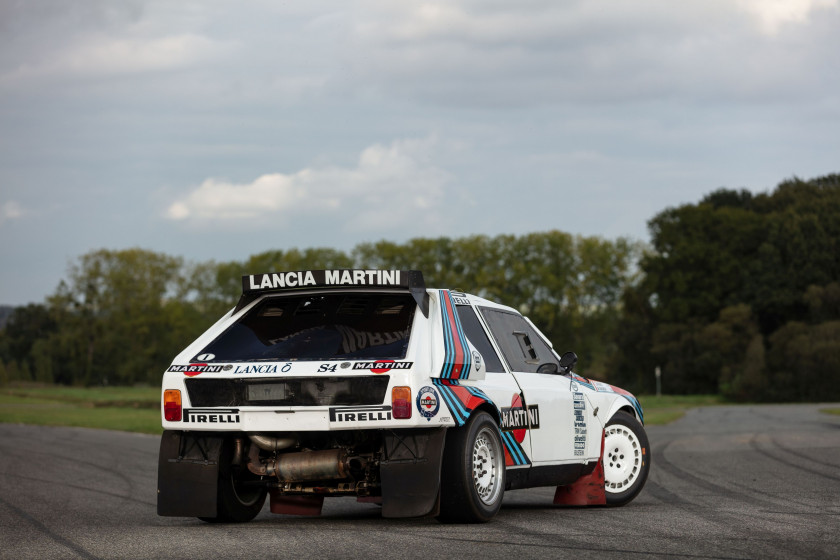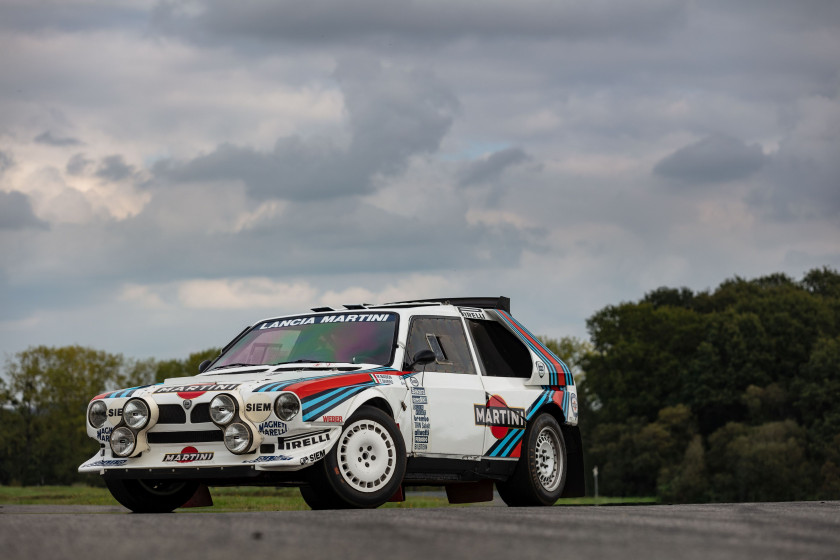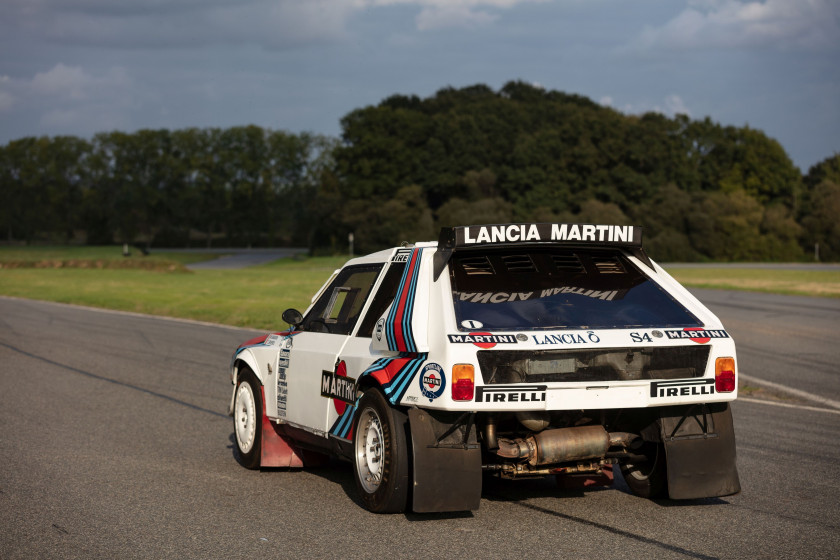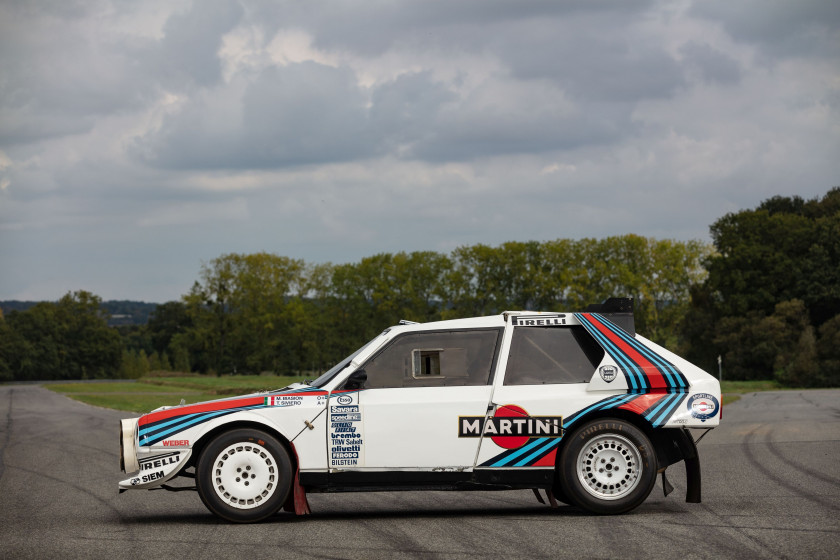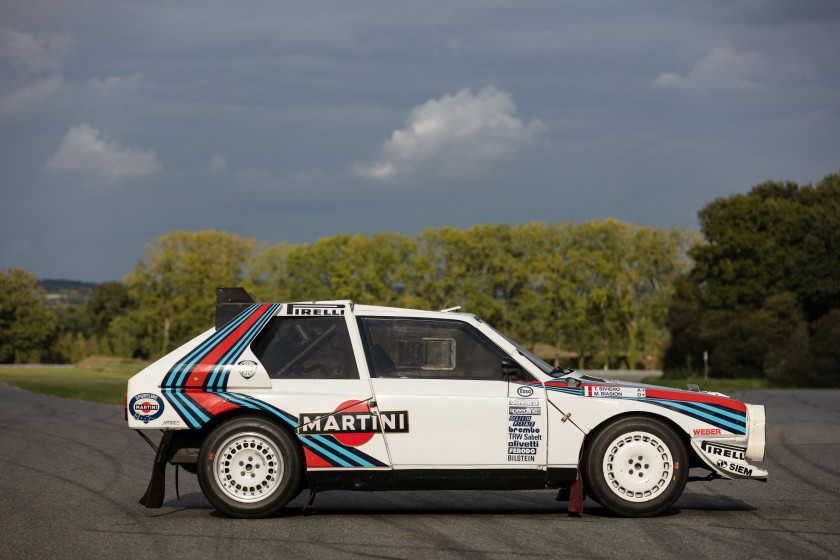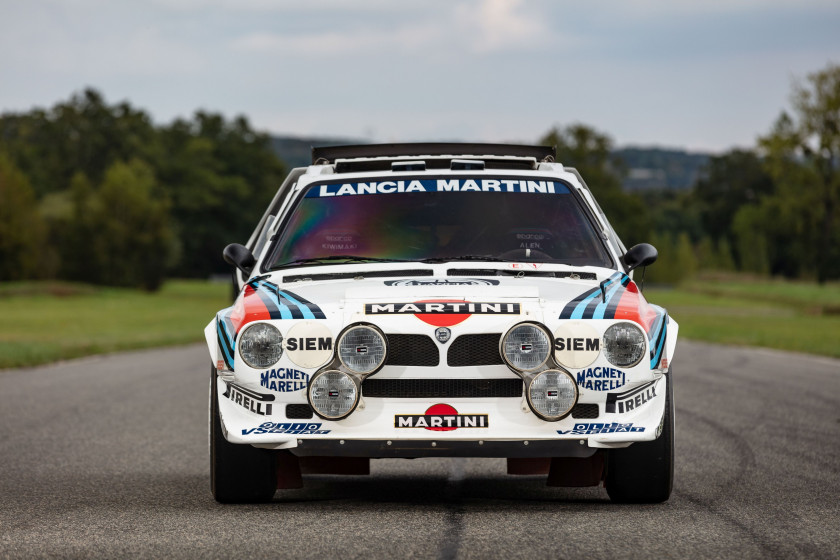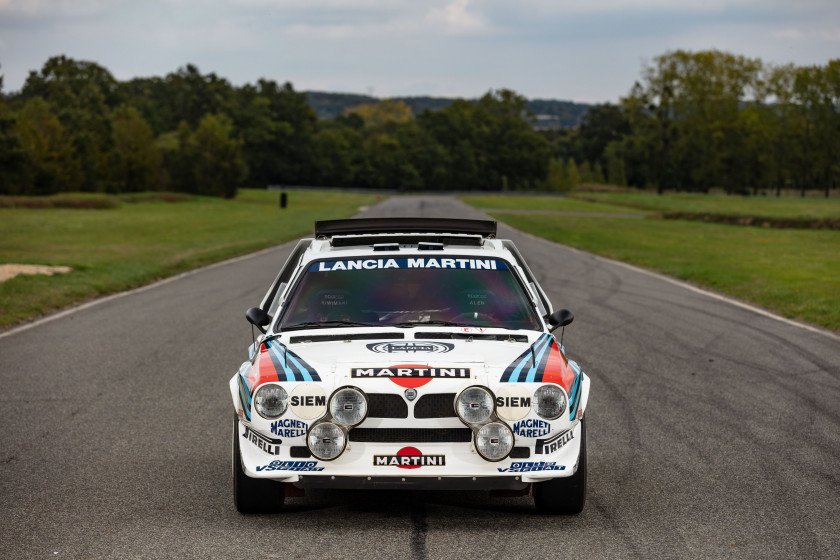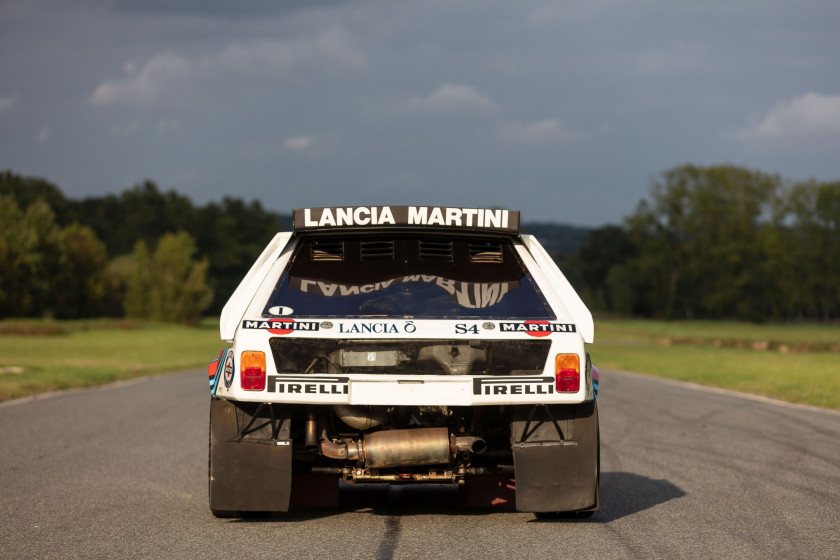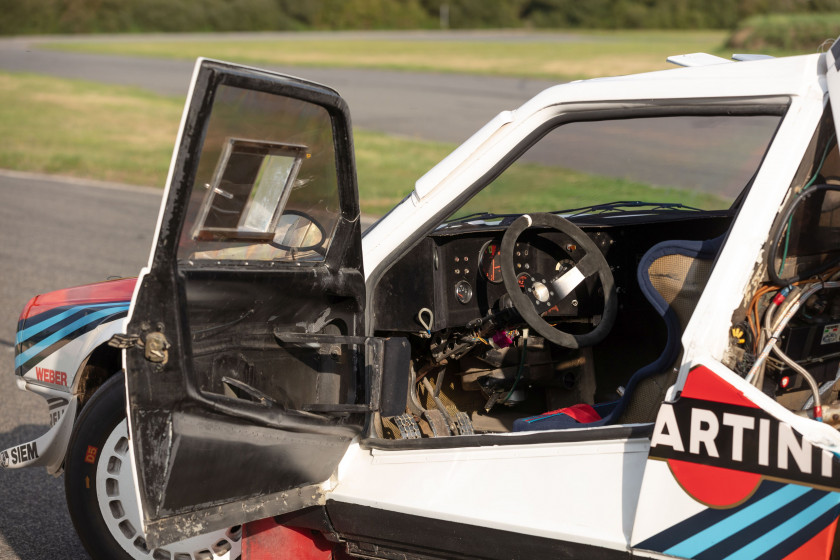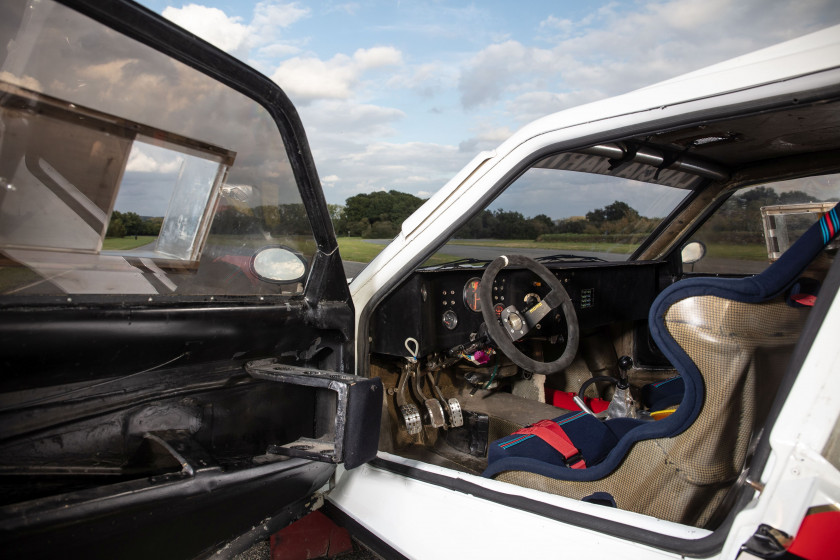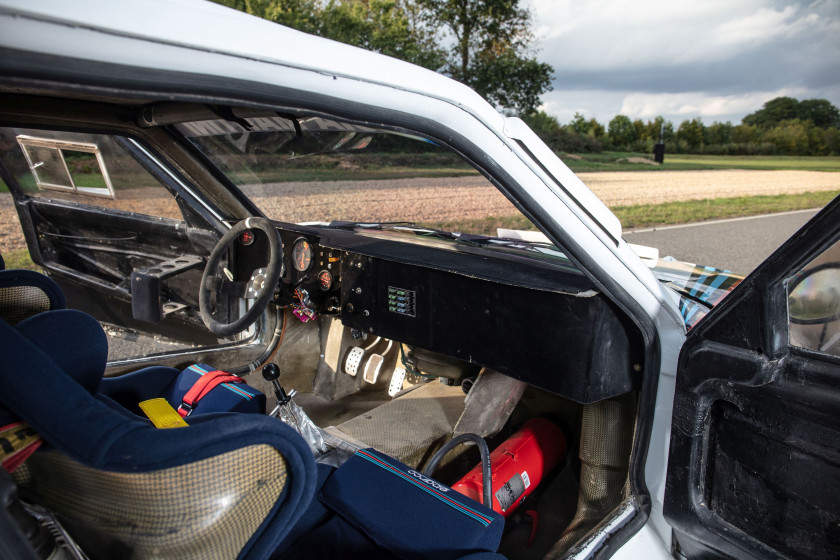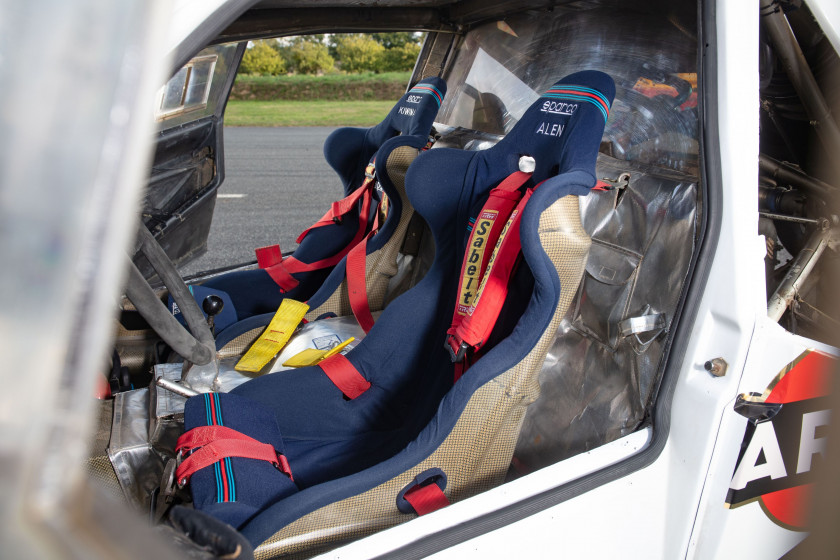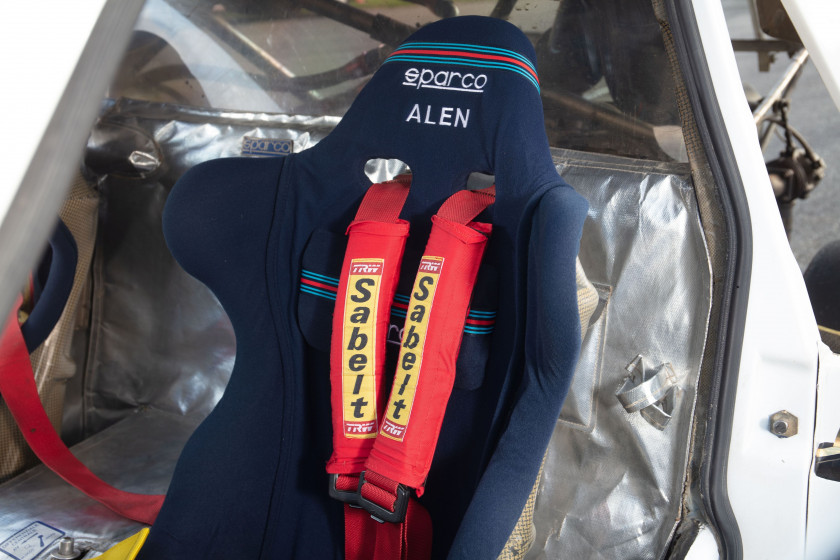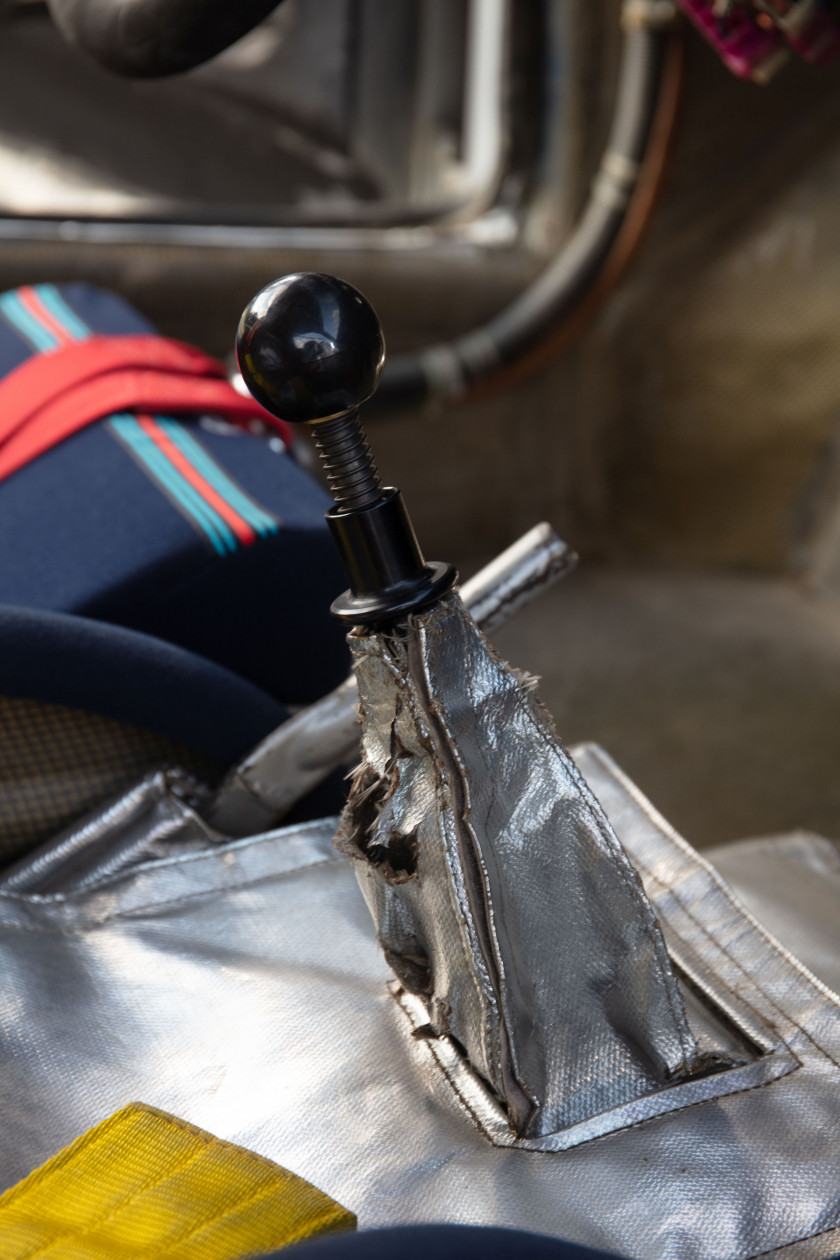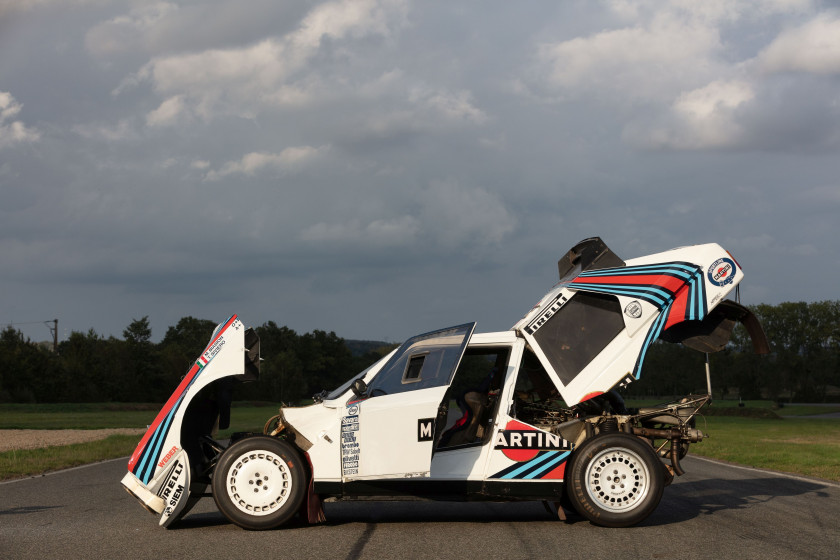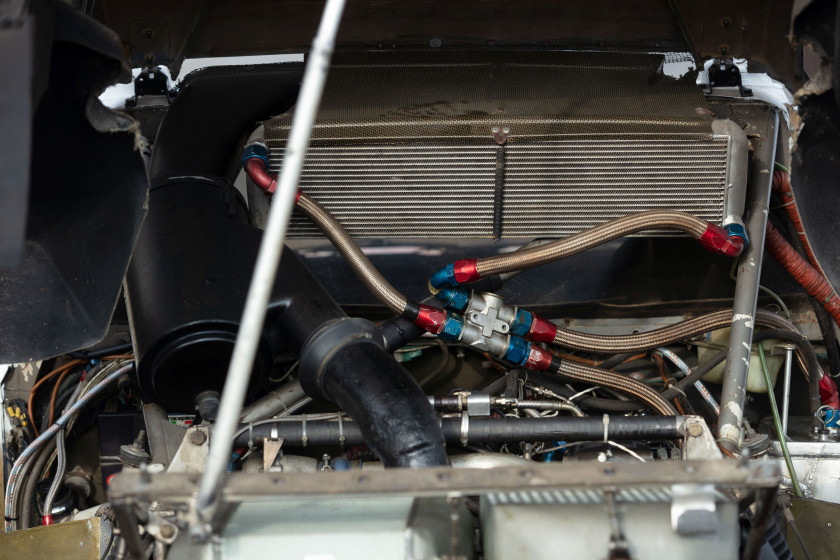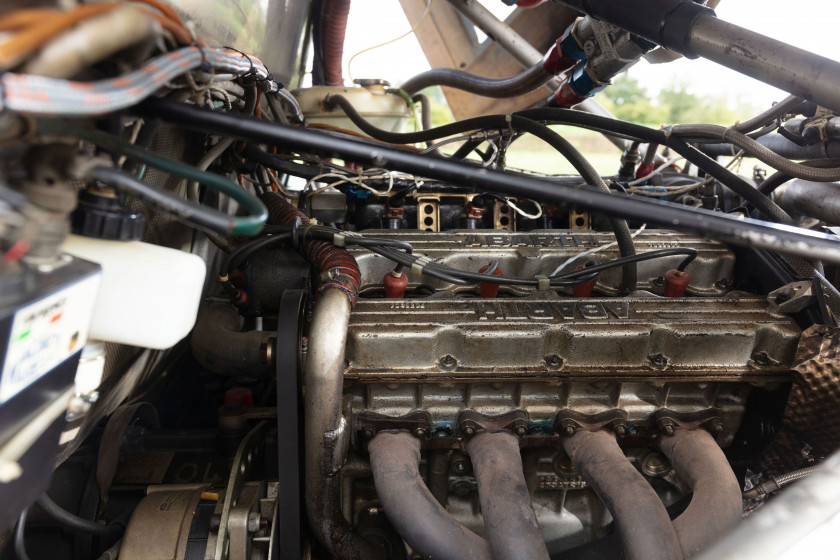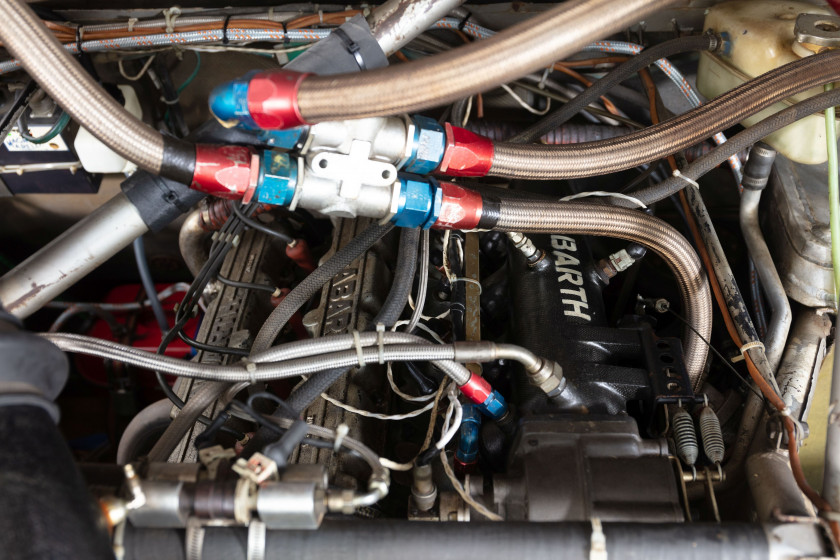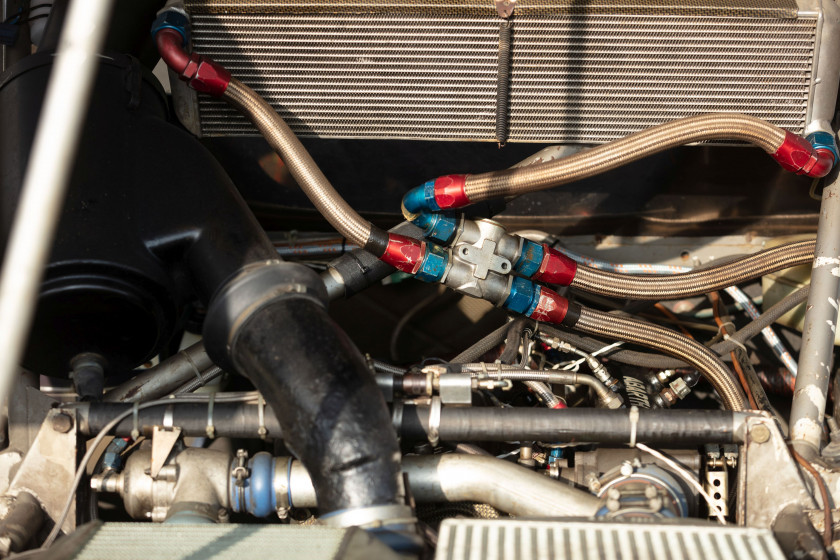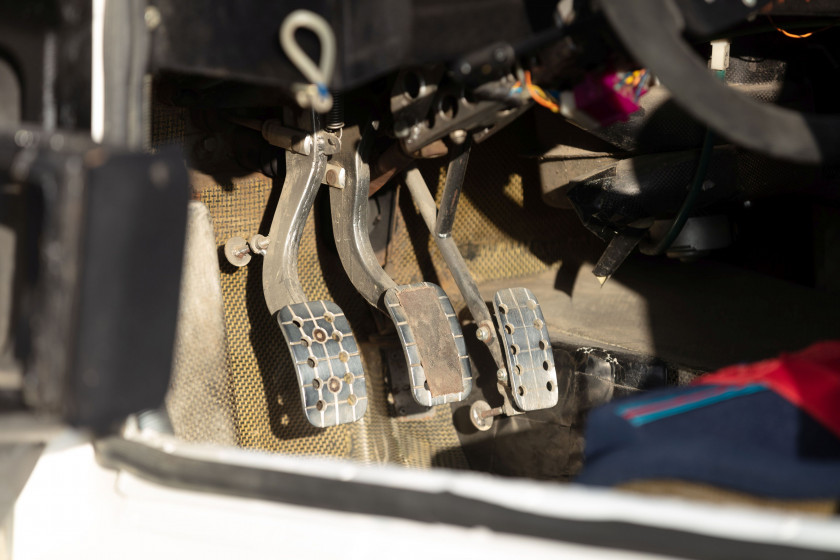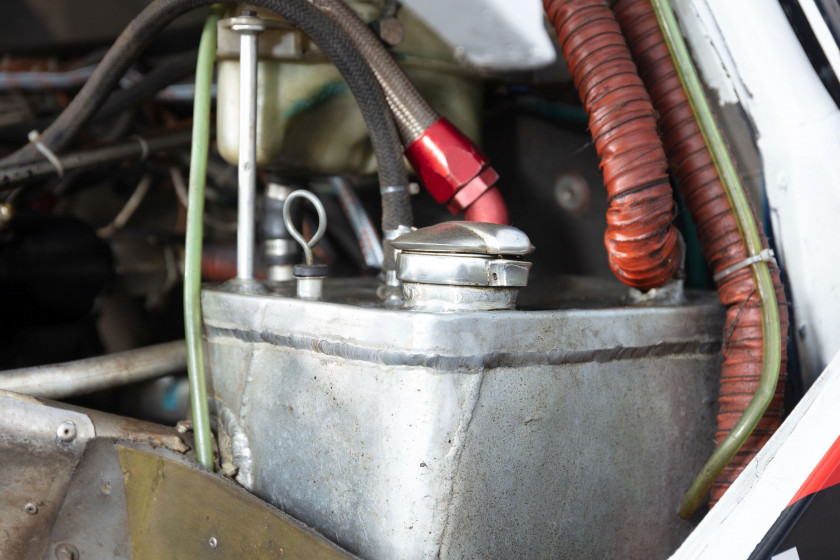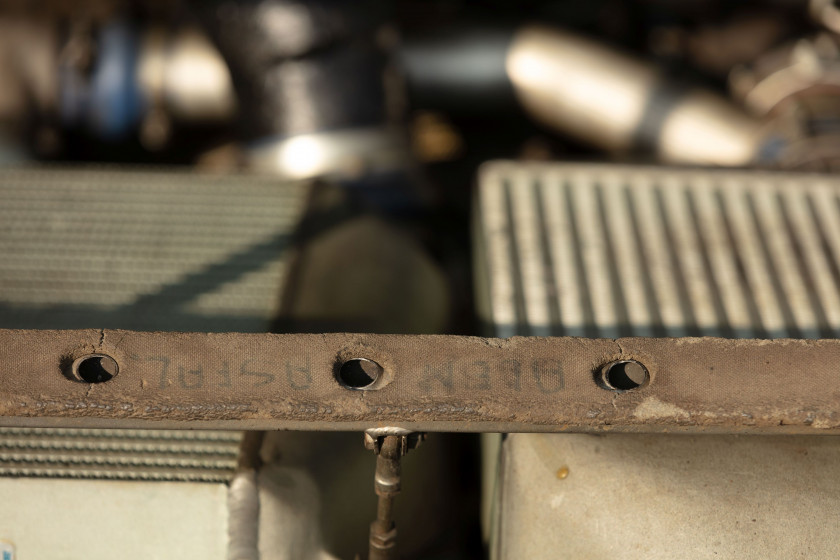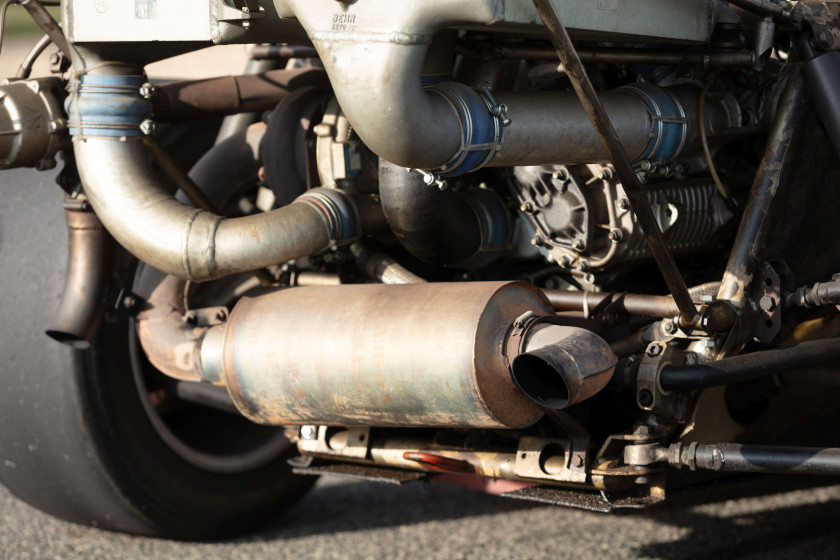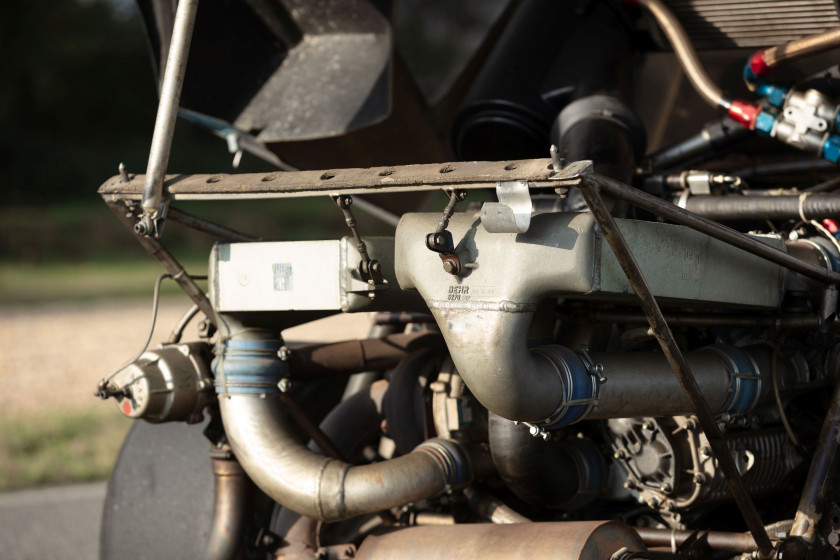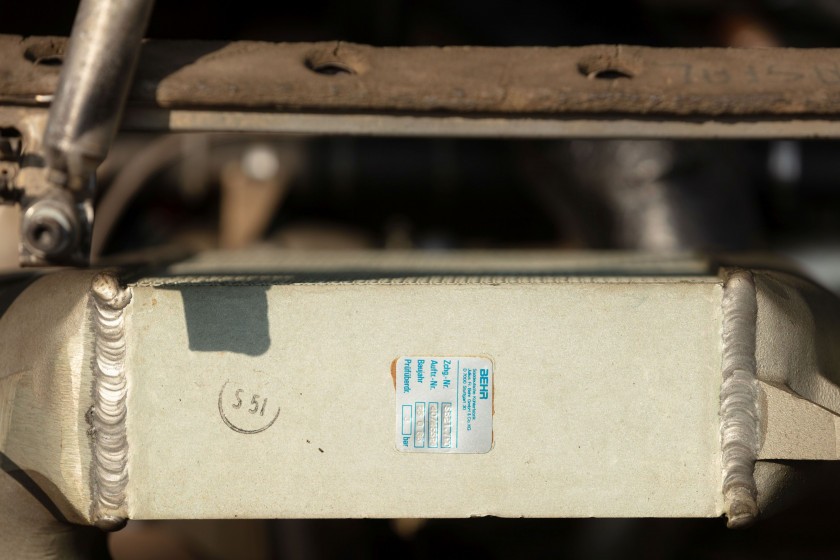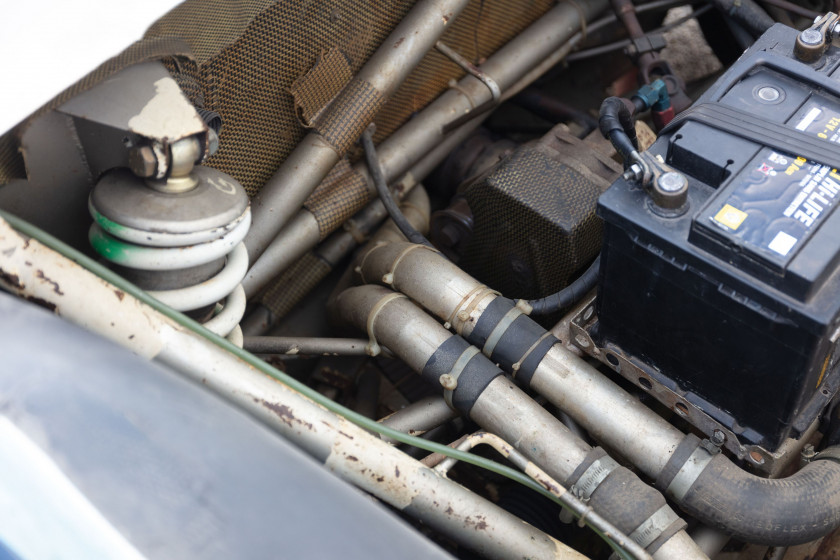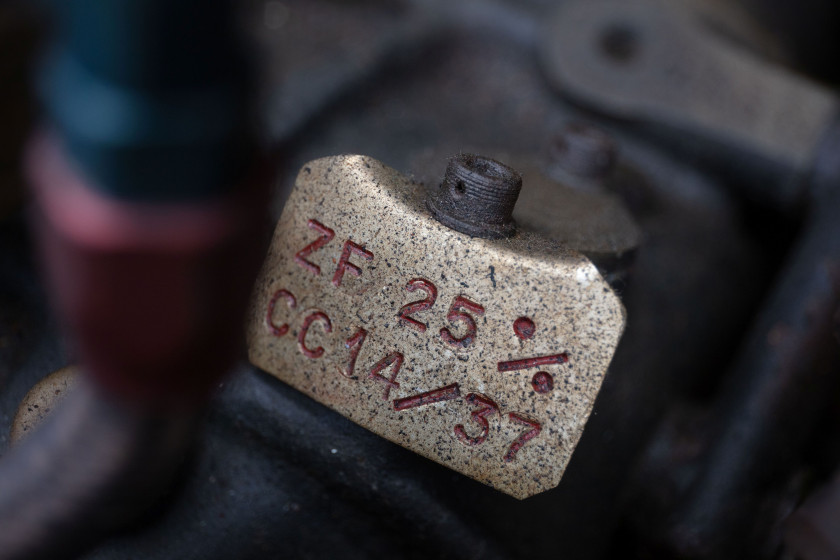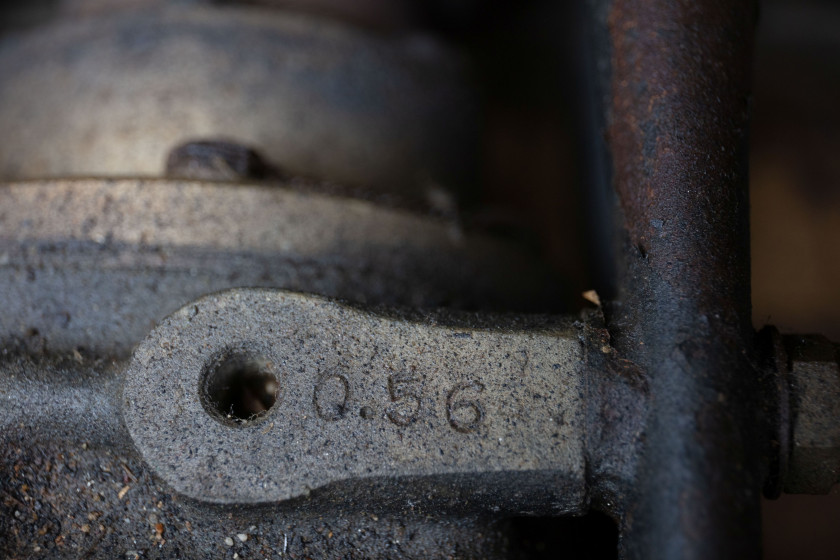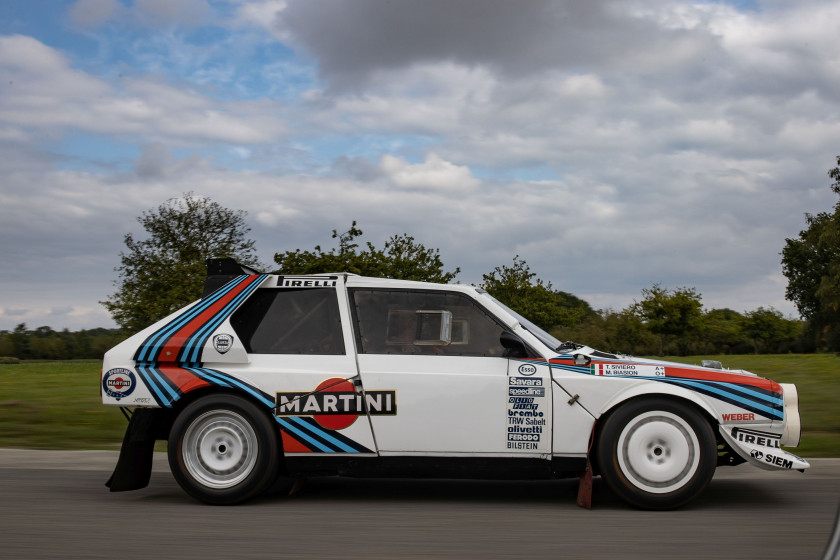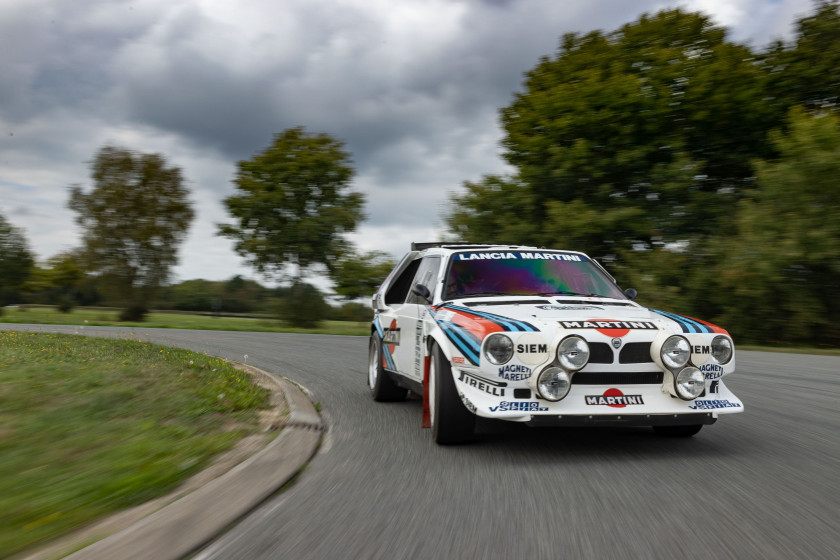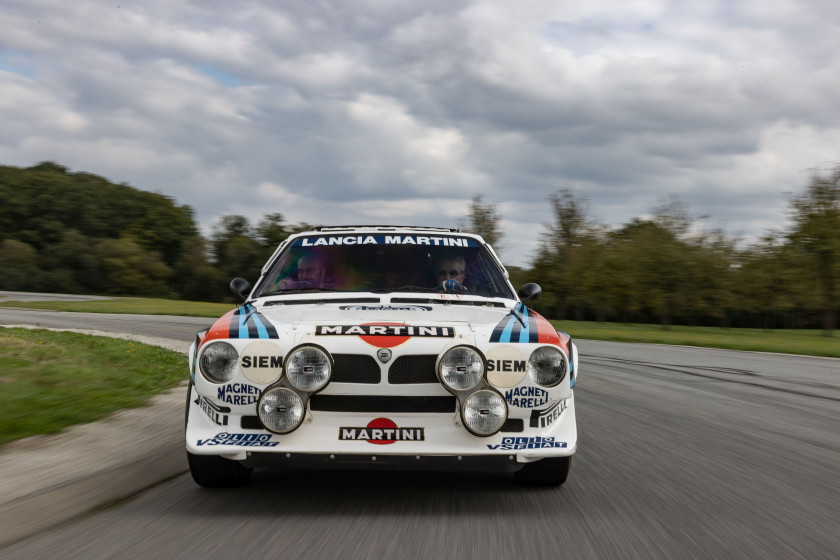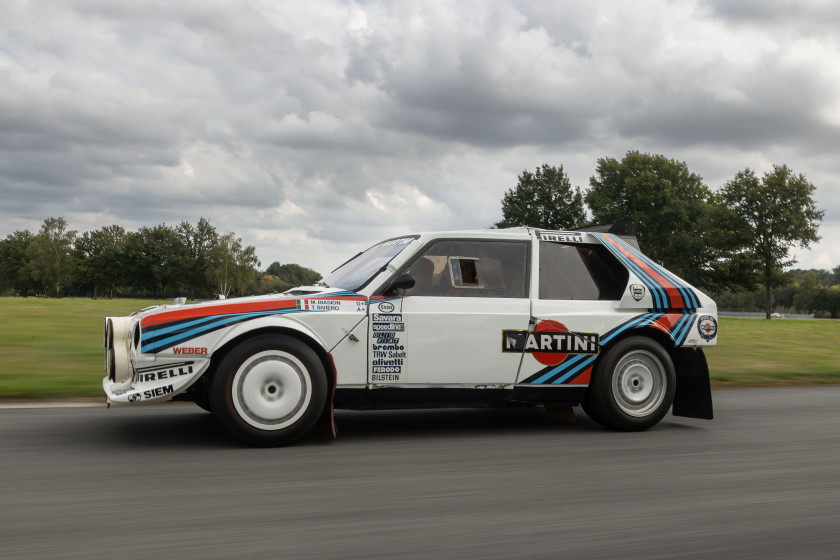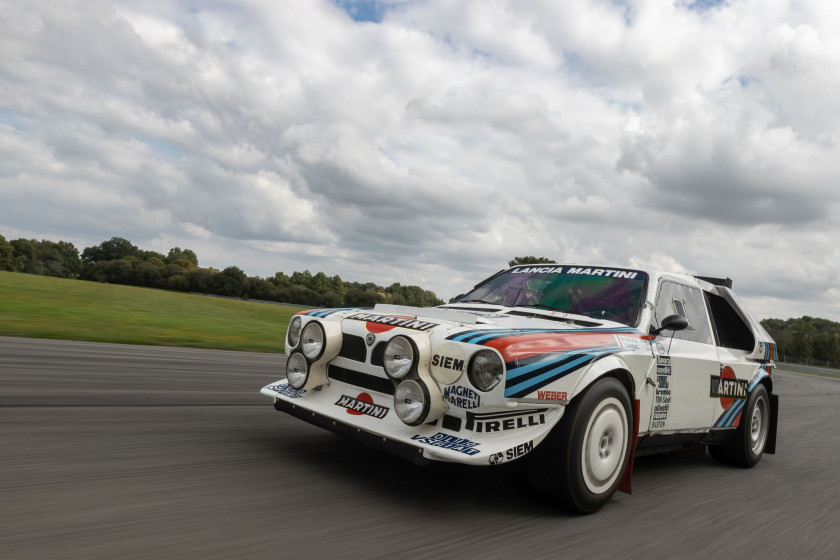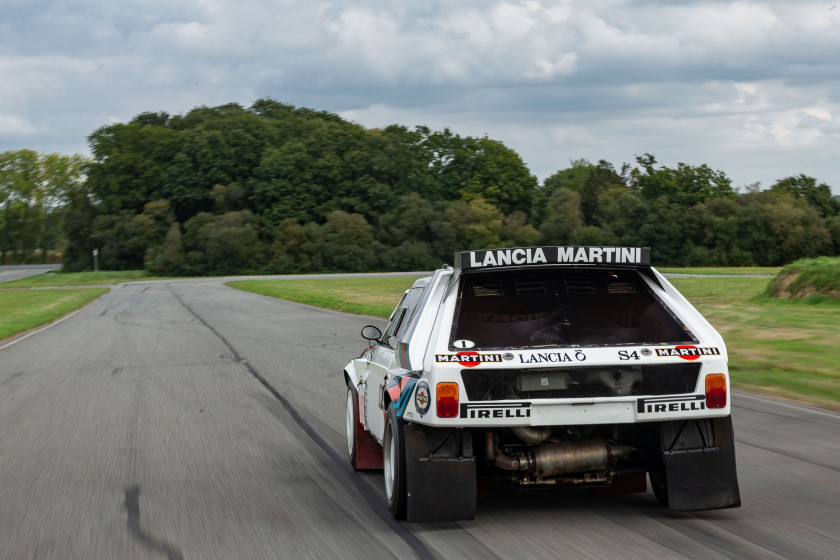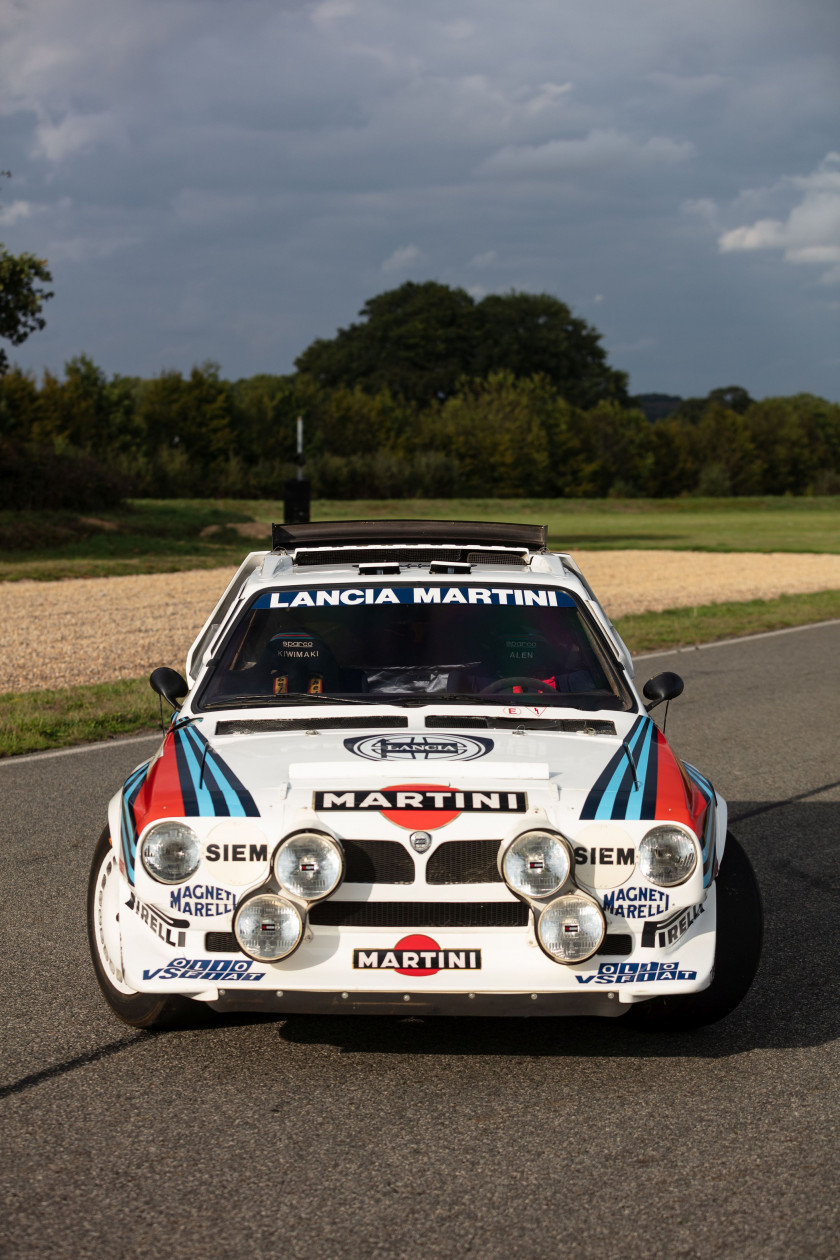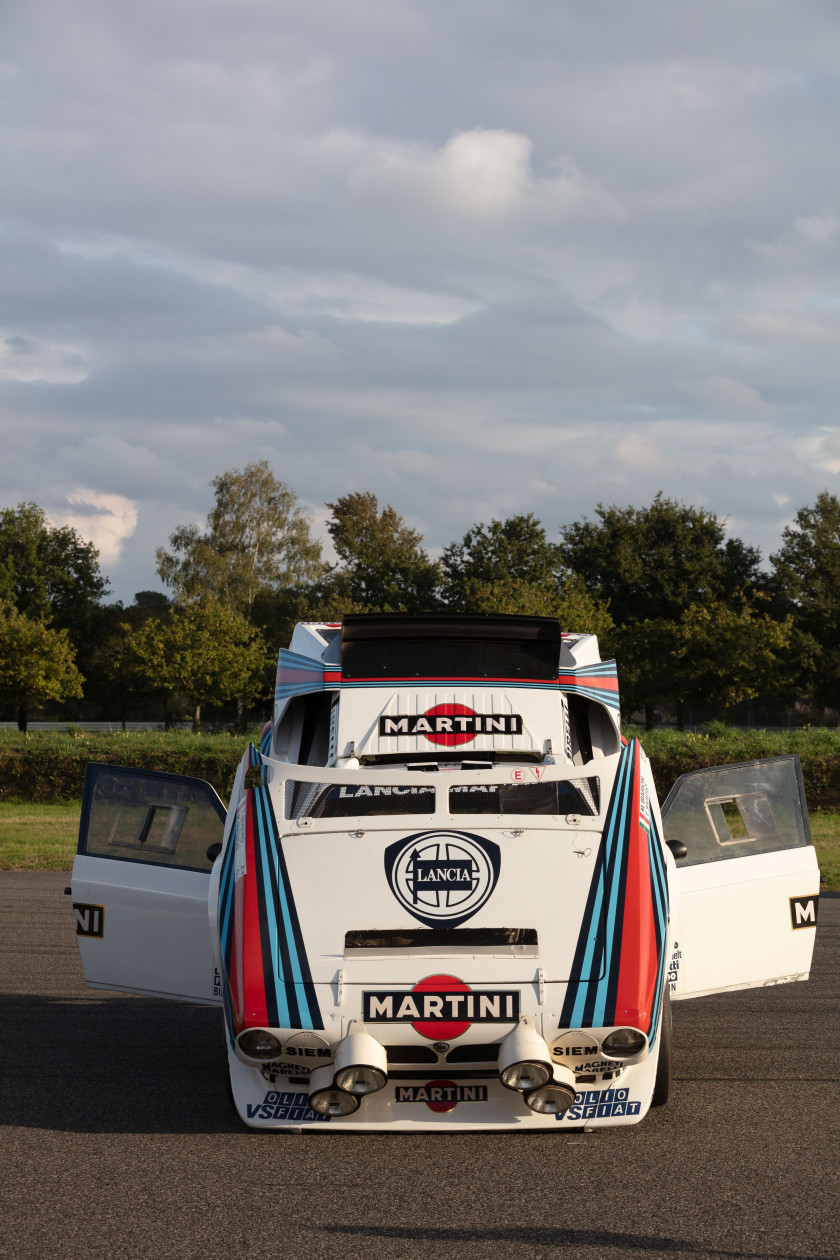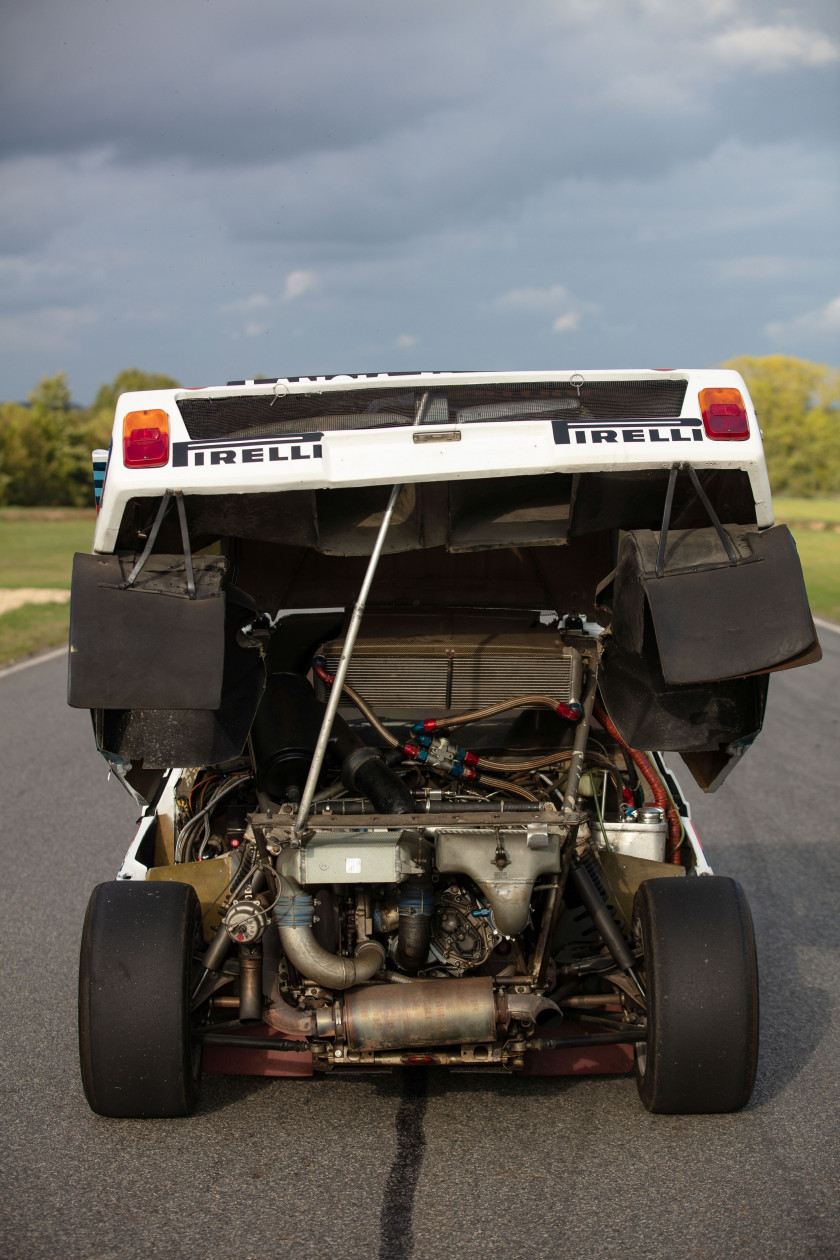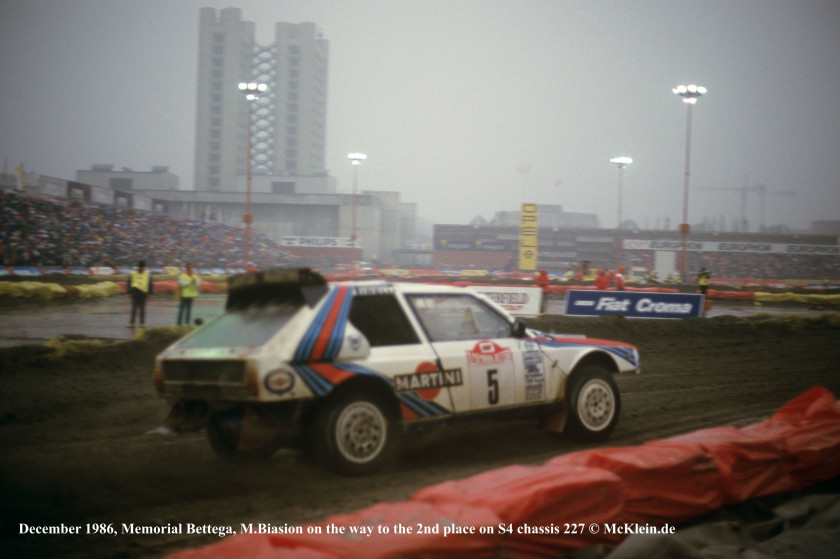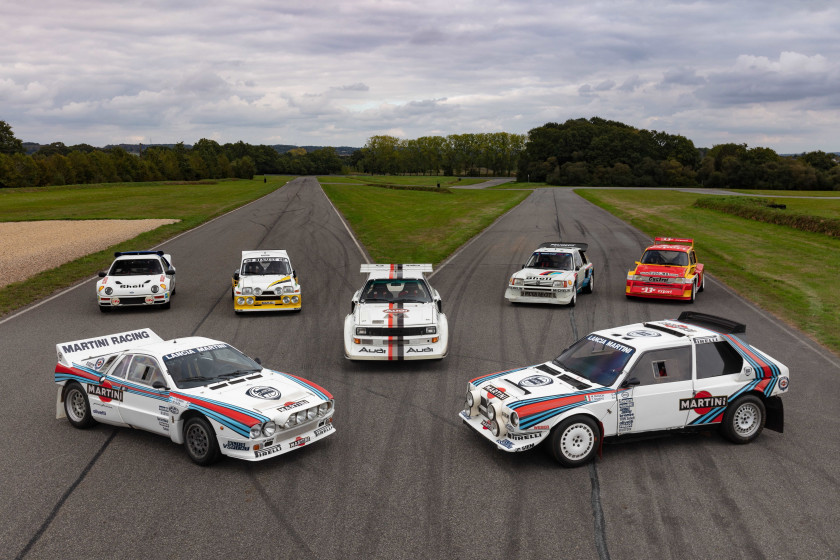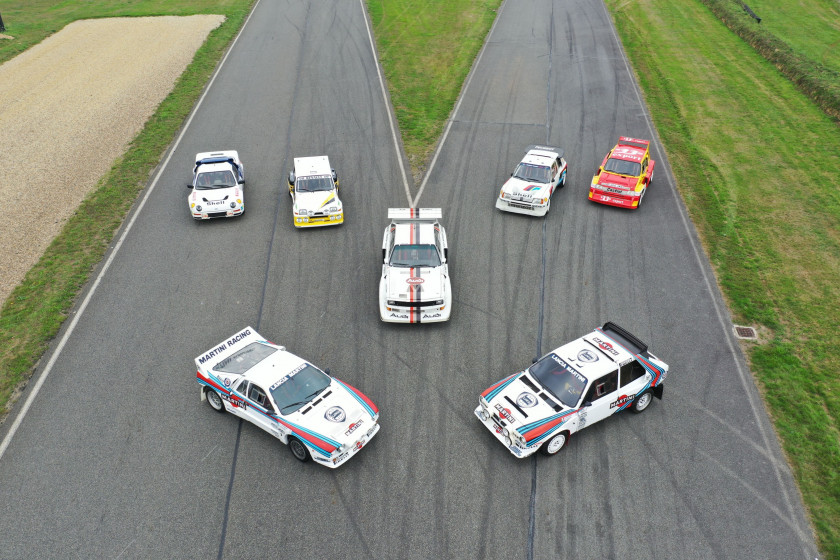Sale Parisienne 2021 - 05 february 2021 /Lot 8 1986 Lancia Delta S4
1986 Lancia Delta S4
Véhicule de compétition
Sans titre de circulation
Châssis n° 227
- Rare Groupe B d'usine authentique
- A couru dans la livrée Lancia Martini avec M. Biasion en 1986
- Historique suivi, depuis 1988 entre les mains du propriétaire actuel
- Ex Bruno Saby, un des meilleurs pilotes de rallye des années 1980
Au début du Groupe B, Lancia s'engage au Championnat du Monde des Rallyes avec la 037, voiture légère et efficace. Mais sa transmission traditionnelle aux seules roues arrière avoue ses limites face à la concurrence et notamment aux Audi Quattro et Peugeot 205 T16 qui, avec leur transmission intégrale, font des merveilles.
Pour que Lancia retrouve sa place au sommet des classements, Cesare Fiorio et Claudio Lombardi décident de partir d'une feuille blanche et vont donner naissance à la Delta S4. Souhaitant rester au-dessous de 900 kg, ils limitent la cylindrée à 1 759 cm3 pour respecter le rapport imposé par le règlement. Ils mettent au point un nouveau moteur 16 soupapes entièrement en aluminium, dont ils souhaitent extraire au moins l'équivalent des 450 ch de celui de la Peugeot. Pour compenser les défauts du turbocompresseur (faible puissance à bas régime, temps de réponse), Lombardi a l'idée d'associer pour la première fois un turbo et un compresseur à commande mécanique, le Volumex : le résultat est un moteur à la fois souple et puissant. L'indispensable transmission intégrale comporte un coupleur Ferguson qui permet une répartition qui peut varier de 40/60 avant/arrière à 100% en faveur de l'arrière. Placée longitudinalement et en évitant tout porte-à-faux, cette mécanique trouve place dans un châssis tubulaire renforcé de panneaux de Kevlar et de carbone, le tout étant habillé d'une carrosserie en fibre de verre évoquant la forme de la Delta de série.
Prévue pour entrer dans la ronde des rallyes au milieu de la saison 1985, la Lancia Delta S4 fait finalement sa première apparition officielle en novembre, au rallye du RAC. Prouvant d'emblée ses qualités, elle remporte les deux premières places entre les mains de Henri Toivonen et Markku Alen. L'année suivante, le titre se joue au coude-à-coude avec Peugeot et, à la fin de la saison, Lancia est en tête mais l'annulation par la FIA du résultat du Rallye de San Remo proclame la victoire de Peugeot. Entretemps est survenu le dramatique accident de Henri Toivonen au Tour de Corse et l'annonce de l'arrêt du Groupe B. Il est légitime de penser que l'expérience acquise avec la S4 a profondément aidé l'équipe Lancia à bâtir l'aventure de la Delta HF Integrale qui, de 1987 à 1992, va dominer la scène des rallyes.
La voiture de la vente
La Lancia Delta S4 d'usine que nous présentons est sortie du département Compétition Abarth en 1986 en configuration Groupe B. En livrée Lancia Martini, immatriculée TO 52127 F, elle a magnifiquement démarré sa carrière en décembre 1986 avec une deuxième place au "Memorial Bettega" où elle était engagée comme voiture officielle entre les mains de Miki Biasion. Elle portait le numéro de course 2. La voiture gagnante était celle de Markku Alen qui était le châssis 228 immatriculée TO 52126 F.
Avec la disparition du Groupe B, les voitures ont connu un arrêt soudain et les constructeurs et pilotes se sont tournés vers d'autres disciplines pouvant accueillir ces machines. C'est ainsi qu'on a revu cette voiture en 1987 aux 24 Heures de Chamonix où se sont relayés au volant Miki Biasion et Bruno Saby.
Il existait une autre spécialité où les Groupe B étaient acceptées : le Rallycross. Se déroulant sur circuit fermé, il pouvait assurer une sécurité que ne permettait pas le rallye. C'est cette direction qu'a pris cette Delta S4, grâce à Bruno Saby.
Revenons un peu en arrière : en 1985 et 1986, le célèbre pilote grenoblois court pour Peugeot et, quand le Groupe B s'arrête, le constructeur de Sochaux lui propose de participer au Paris-Dakar avec les 205 Turbo 16. "J'ai refusé la proposition car je ne me sentais pas prêt pour le rallye-raid," nous a indiqué Bruno Saby. "Et surtout, je rêvais de remporter le Rallye de Monte-Carlo." Il s'y engage en 1987 avec Lancia Martini qui fait courir les Delta HF 4x4 Groupe A, mais doit abandonner sur panne de transmission alors qu'il est aux avant-postes. La chance lui sourit en 1988 où il réalise enfin son rêve et remporte en janvier le célèbre rallye.
"Après le Groupe B, le programme des constructeurs était réduit et en 1988 j'ai donc eu l'idée de participer au Championnat de France de Rallycross et de créer ma propre équipe, Grenoble Sport Auto. Lancia m'a aidé, de même que le Groupe Hommell qui était à l'origine du Rallycross en France. Et avec l'accord de Cesare Fiorio, nous avons pu récupérer une Lancia Groupe B officielle." C'est la n°227. Selon Olivier Quesnel, qui dirige alors le Groupe Hommell, "elle était destinée à un patron de Fiat, mais il accepté qu'elle nous soit vendue car il considérait que les voitures devaient être utilisées."
Préparée chez Grenoble Sport Auto pour cette nouvelle discipline avec le soutien officiel de Lancia, elle se présente aux couleurs de Métal 5 et va connaître une saison extrêmement disputée, comme le rappelle Olivier Quesnel : "Nous avons eu une saison d'enfer contre Peugeot. Lors de la dernière épreuve, nos deux équipes étaient à cinq victoires chacune. " Bruno Saby poursuit : "Tout au long de la saison je me suis battu contre Guy Fréquelin, ami et rival de longue date, qui avait une 205 T16. La dernière course avait lieu à Trappes et nous étions à égalité de victoires, cinq partout, donc cette dernière épreuve était déterminante. Vous savez qu'en Rallycross, partir en tête est primordial car il est impossible ensuite de doubler. Et là, la 205 avait un moteur Pikes Peak extrêmement puissant et Guy est arrivé devant moi au premier virage. Nous avons fait toute la course capot contre coffre et il a passé la ligne d'arrivée un demi-capot devant moi. C'est une saison dont on se souviendra !"
Après cette année mémorable, la voiture, acquise par Michel Hommell, a pris directement la direction du Musée de Lohéac en Bretagne. "Nous étions en train de constituer la collection de Groupe B," confirme Olivier Quesnel. "La voiture a été remise dans sa livrée Lancia Martini d'origine et elle a immédiatement intégré le musée."
Elle est donc aujourd'hui dans un état d'origine exceptionnel, avec un historique qui l'est tout autant. Née voiture d'usine, habillé de la mythique livrée Martini, elle a ensuite évolué entre les mains d'un des meilleurs pilotes de rallye de son époque, avec l'assistance de Turin. De là, elle est passée directement en exposition où elle a gardé toute son intégrité. C'est sans doute une des Delta S4 s'usine les plus authentiques parmi les survivantes de ces machines exceptionnelles.
"Un de ses atouts était son moteur"
La Lancia Delta S4 a fait partie des plus brillantes des voitures du Groupe B. Pour Bruno Saby, "C'était une voiture très équilibrée pour toute la saison. Un de ses atouts était son moteur. Grâce à l'association du turbo et du compresseur Volumex, on avait de la puissance sur toute la plage de régime. Les voitures du Groupe B étaient exceptionnelles et j'ai eu énormément de chance de bien les connaître. C'est toujours une grande émotion de les retrouver à Lohéac et de reprendre le volant de ma S4 pour quelques tours de circuits."
Markku Alen, fidèle pilote Lancia, connaît bien la S4 : "Avec la 037, la propulsion était toujours un handicap. Il n'était pas vraiment possible de gagner sur la neige ou sur la terre. Nous sommes arrivés très tard avec la S4, mais je m'y suis habitué très rapidement."
Quant à Roberto Vittone, ancien ingénieur Lancia, "la S4 était fantastique, mais nous n'en avons profité qu'une année. Elle a commencé à 430 ch et en approchait 500 à San Remo, mais nous n'avons pas eu le temps de la faire évoluer. Nous aurions pu aller encore plus loin, peut-être gagner encore 30%."
(Propos tirés d'interviews à Classic & Sports Car).
Nous informons les acheteurs que l'ensemble des véhicules de la collection ont été peu utilisés ces dernières années s'agissant d'une collection muséale. Ils sont donc vendus en l'état, sans contrôle technique et devront bénéficier d'une révision générale avant de reprendre la route.
Competition vehicle
Unregistered
Chassis no. 227
- Rare authentic works Group B car
- Competed in Lancia Martini racing colours with Biasion in 1986
- Well-documented history, in current ownership since 1988
- Ex-Bruno Saby, one of the top rally drivers in the 1980s
At the start of Group B, Lancia entered the World Rally Championship with its light and capable 037. But its traditional rear-wheel drive layout had its limitations when compared with competitors such as the Audi Quattro and Peugeot 205 T16, whose four-wheel drive worked wonders.
In order for Lancia to regain its place at the top of the rankings, Cesare Fiorio and Claudio Lombardi decided to start from a blank sheet of paper and created the Delta S4. They wanted to keep its weight under 900 kg and therefore limited the engine capacity to 1759 cc, to comply with the restrictions imposed in the regulations. They developed a new all-aluminium 16-valve engine, which they wanted to match or beat the 450 bhp developed by the Peugeot. To offset the drawbacks of the turbo (lack of power at low revs and delayed response), Lombardi had the original idea of combining a turbo and a mechanical supercharger, the Volumex, resulting in an engine that was both powerful and flexible. Four-wheel drive was essential, and the Ferguson viscous coupling allowed the torque split to be varied from 40/60 front/rear to 100% to the rear. The engine was mounted lengthwise ahead of the rear axle in a tubular chassis strengthened with Kevlar and carbon panels, covered with a fibreglass body styled on the lines of the production Delta.
Planned to enter the rally championship in the middle of the 1985 season, the Lancia Delta S4 finally made its first official appearance in November, on the RAC Rally. It immediately proved its qualities, finishing first and second in the hands of Henri Toivonen and Markku Alen. The following year, the title was a close fight with Peugeot and at the end of the season Lancia was ahead, but the FIA annulled the results of the San Remo Rally, handing victory to Peugeot. Meanwhile, Henri Toivonen was involved in a tragic accident on the Tour de Corse, heralding the end of Group B. It would be reasonable to assume that the experience Lancia gained with the S4 helped it greatly in developing the Delta HF Integrale, which would dominate the world of rallying from 1987 to 1992.
The car for sale
The works Lancia Delta S4 presented here left Abarth's competition department in 1986 in Group B configuration. In the Lancia Martini colours and registered TO 52127 F, its career got off to a flying start in December 1986, when it finished second in the 'Memorial Bettega', as an official entry driven by Miki Biasion with the racing number 2. Markku Alen was at the wheel of the winning car: chassis number 228, registered TO 52126 F.
With the cancellation of Group B, the cars came to an abrupt standstill, and the manufacturers and drivers turned to other branches of motorsport for which the cars were eligible. This car could thus be seen again in 1987 during the 24 Heures de Chamonix ice race, when Biasion and Saby took turns behind the wheel. The Group B cars were also accepted in another discipline, that of rallycross. These events took place on closed tracks, ensuring a greater degree of safety than rallying. This was the direction taken by this Delta S4, thanks to Saby.
But let's go back a bit: in 1985 and 1986, Saby was driving for Peugeot and when Group B came to an end, Peugeot invited him to take part in the Paris-Dakar with the 205 Turbo 16. "I turned down their offer as I didn't feel ready for that kind of long-distance rally", Saby told us. "And, above all, my dream was to win the Monte-Carlo Rally." He entered the 'Monte' in 1987 with Lancia Martini, which was fielding the Group A Delta HF 4x4s, but had to retire due to transmission failure when he was among the leaders. He was in luck in January 1988, when he finally fulfilled his dream and won the famous rally.
"After Group B, the manufacturers scaled back their programmes, and in 1988 I therefore had the idea of taking part in the French Rallycross Championship and setting up my own team, Grenoble Sport Auto. Lancia helped me, as did the Hommell Group, which was the instigator of rallycross in France. And with Cesare Fiorio's agreement, we were able to pick up an official Group B Lancia." It was number 227. According to Olivier Quesnel, who was running the Hommell Group at the time, "it was intended to go to one of Fiat's directors, but he agreed to sell it to us, as he believed cars were meant to be used."
Prepared by Grenoble Sport Auto for this new discipline with official support from Lancia, it sported the colours of 'Métal 5' and embarked on a fiercely contested season, as Quesnel recalls: "We had one hell of a fight with Peugeot that year. Going into the final round, our teams had five wins each." Saby continues the story: "Throughout the season, I had been battling against Guy Fréquelin, an old friend and rival, who had a 205 T16. The last round was held at Trappes and we had five wins each, so this last race would be decisive. In rallycross, starting in the lead is essential, as afterwards it's impossible to overtake. Well, the 205 had an extremely powerful Pikes Peak engine and Guy went into the first corner ahead of me. We were bumper to bumper throughout the race and he crossed the finish line half a bonnet's length in front of me. That was a season we'll always remember!"
After this memorable year, the car was bought by Michel Hommell and headed for the museum. "We were in the process of establishing the Group B collection", Quesnel confirms. "The car was restored to its original Lancia Martini livery and immediately took its place in the museum."
Today, it is in exceptional original condition, with an equally remarkable history. A works car from the start, in the legendary Martini colours, it was driven by one of the top rally drivers of its time, with support from Turin. Immediately after this, it became part of an exhibition, where its integrity has been preserved. Of all these exceptional cars, it is undoubtedly one of the most authentic works Delta S4s to survive.
"One of its strengths was its engine"
The Lancia Delta S4 was one of the most outstanding cars in Group B. For Bruno Saby, "It was a very well-balanced car for the whole season. One of its strengths was its engine. Thanks to the combination of the turbo and the Volumex supercharger, we had power across the rev range. The Group B cars were exceptional, and I was enormously lucky to have known them. It's always an emotional moment when I see them at Lohéac and get behind the wheel of my S4 for a few laps of the track."
Markku Alen, a loyal Lancia driver, knows the S4 well: "The 037's rear-wheel drive was always a handicap. You couldn't really win on snow or gravel. We arrived very late with the S4, but I quickly got used to it."
Roberto Vittone, a former Lancia engineer, adds: "The S4 was fantastic, but we only had it for a year. It started out with 430 bhp and was close to 500 bhp at San Remo, but we didn't have enough time to develop it. We could have gone further and maybe got another 30% from it."
(Comments taken from interviews in Classic & Sports Car)
We inform buyers that all the vehicles in the collection have been little used during the last years as they are part of a museum collection. They are sold as presented and therefore require recommissioning before being driven on the road.
COLLECTION MICHEL HOMMELL ET OLIVIER QUESNEL
LE MANOIR DE L'AUTOMOBILE - LOHEAC
Au début des années 1970, j'ai eu le privilège de rencontrer Michel Hommell et Olivier Quesnel, avant qu'eux-mêmes cultivent une amitié idéale.
Olivier, meilleur ami de jeunesse de Patrick Tambay, débutait une carrière d'attaché de presse au sein du Simca Racing Team, avant de rejoindre Jean Todt chez Peugeot Talbot Sport, et Michel Hommell, ancien de la coupe R8 Gordini, diversifiait son groupe de presse né de la course et du titre phare " Echappement ", quand à l'issue d'un premier dîner ils partagèrent ce sentiment singulier de se connaître depuis toujours. Créant les occasions de se revoir et notamment au squash dont le perdant offrait une caisse de vin, l'éditeur provoquait : " Je te demanderai de me rejoindre quand j'aurai les moyens de rémunérer tes talents ".
La boutade prit effet en 1984 et six mois plus tard, Olivier hérita de la gestion du Groupe. Durant 25 ans les deux amis vécurent sans ombre dans le même bureau, l'un serein, optimiste et tenace, l'autre rigoureux, à l'esprit vif et de synthèse, les deux visionnaires.
A la fin des années 1980, Jacky Setton avait réuni dans son château de Wideville des Formules 1 " gagnantes " dont je décrivis dans " Une Collection d'avance ", le sens, l'originalité et l'ambition de la démarche. Le même souci de l'excellence anima les deux complices dans la discipline des rallyes, avec ces Groupe B au palmarès de feu, bluffés par leurs performances et le courage et la virtuosité des pilotes à les dompter. Michel et Olivier étaient nourris par leur implication active, pour la saison 1988 dans le championnat de France de Rallycross, aux côtés du talentueux Bruno Saby au volant de la monstrueuse Lancia Delta S4 aux couleurs de Metal 5. Cette S4 allait former la pierre angulaire d'une collection qu'ils allaient chiner dans toute l'Europe, alors que ces éphémères et emblématiques Groupe B venaient juste de quitter la scène, assurant à la collection une authenticité et un charme inégalable. La salle des Groupe B, demeurait dans le musée de Lohéac, l'un des passages les plus exaltants, mêlant à la brutalité aride de ces beautés victorieuses le recueillement et l'admiration qui étaient dû aux talents de leurs pilotes, funambules fragiles sur le fil de la vie.
En 2008 Olivier se vit offrir la direction de Citroën Racing puis de Peugeot Sport l'année suivante. Bilan : 4 titres de champion du monde pilote et constructeur au bénéfice des chevrons et deux premières places au Mans 2009 ainsi qu'un titre mondial d'endurance en 2011 au bénéfice du Lion.
Hommell s'était lui construit une sorte de féodalité dont il était le seigneur bienveillant, à la fois festive en réanimant un village endormi, Lohéac, muséale, avec une réunion de plus de 400 voitures et une exposition Arts et Traditions populaires, et sportive, en construisant un circuit capable d'accueillir une manche du Championnat du monde de Rallycross….
Cette amitié perdure, intacte et entretenue sans qu'il y ait davantage à dire de ce bel attachement que Montaigne à l'adresse de la Boétie : " parce que c'était lui, parce que c'était moi ".
La collection est le reflet du caractère des inséparables, des compétiteurs !
Hervé Poulain
At the start of the 1970s, I had the privilege of meeting Michel Hommell and Olivier Quesnel, before they had forged the perfect collaboration.
Olivier, Patrick Tambay's closest childhood friend, started his career working in PR for the Simca Racing Team, before joining Jean Todt at Peugeot Talbot Sport, and Michel Hommell, a former R8 Gordini Cub competitor, was diversifying his motorsport-themed publishing group, which included the flagship publication " Echappement ". Following a first dinner they shared the uncanny feeling of having known each other forever. They found reasons to meet, particularly for games of squash where the loser offered the winner a case of wine, and the publisher vowed : " I will ask you to join me when I have the means to pay for your talents ".
This came to pass in 1984 and six months later, Olivier took over the running of the group. For the next 25 years, the two friends lived in each other's shadow, working in the same office. Two visionaries, one calm, optimistic and tenacious, the other rigorous, quick-witted with an eye for the big picture.
At the end of the 1980s, in his château in Wideville, Jacky Setton assembled a collection of Formula 1 " winners ", with a vision, originality and ambition that I have described in " Une Collection d'Avance ". It was with the same aim that our two accomplices approached the rally discipline, amazed by the performance of these cars and the courage and skill required by the drivers to tame them. Michel and Olivier were boosted by their own involvement, during the 1988 season in the French Rallycross Championship, with the talented Bruno Saby at the wheel of the monstrous Lancia Delta S4 in Metal 5 colours. This S4 would form the cornerstone of a collection they went on to assemble from across Europe, just as these ephemeral and iconic Group B cars were leaving the scene, providing an obvious appeal and a guaranteed authenticity. The Group B room is one of the most thrilling sections of the museum in Lohéac, combining the uncompromising brutality of these victorious beauties with an admiration for the talents of their drivers, tightrope walkers on the fragile thread of life.
In 2008 Olivier was offered the management of Citroën Racing, and Peugeot Sport the following year. The result : 4 driver's and constructor's world championship titles for Citroën and two first places at Le Mans in 2009, as well as a World Endurance title in 2011 for Peugeot. Meanwhile, Hommell built himself a kind of feudalism of which he has become the benevolent lord. It offers a celebration, reanimating the sleepy village of Lohéac, a museum, bringing together more than 400 cars, an exhibition of popular Arts and Traditions, and sport, with the creation of a circuit capable of hosting a round of the Rallycross World Championship…
The friendship continues, as strong as ever, summed up by the words of Montaigne talking about La Boétie: " because it was him, because it was me ".
The collection reflects the personality of these two inseparable competitors !
Hervé Poulain
Photos © Peter Singhof
Estimation 600 000 - 800 000 €
Sold 810,560 €
* Results are displayed including buyer’s fees and taxes. They are generated automatically and can be modified.
Véhicule de compétition
Sans titre de circulation
Châssis n° 227
- Rare Groupe B d'usine authentique
- A couru dans la livrée Lancia Martini avec M. Biasion en 1986
- Historique suivi, depuis 1988 entre les mains du propriétaire actuel
- Ex Bruno Saby, un des meilleurs pilotes de rallye des années 1980
Au début du Groupe B, Lancia s'engage au Championnat du Monde des Rallyes avec la 037, voiture légère et efficace. Mais sa transmission traditionnelle aux seules roues arrière avoue ses limites face à la concurrence et notamment aux Audi Quattro et Peugeot 205 T16 qui, avec leur transmission intégrale, font des merveilles.
Pour que Lancia retrouve sa place au sommet des classements, Cesare Fiorio et Claudio Lombardi décident de partir d'une feuille blanche et vont donner naissance à la Delta S4. Souhaitant rester au-dessous de 900 kg, ils limitent la cylindrée à 1 759 cm3 pour respecter le rapport imposé par le règlement. Ils mettent au point un nouveau moteur 16 soupapes entièrement en aluminium, dont ils souhaitent extraire au moins l'équivalent des 450 ch de celui de la Peugeot. Pour compenser les défauts du turbocompresseur (faible puissance à bas régime, temps de réponse), Lombardi a l'idée d'associer pour la première fois un turbo et un compresseur à commande mécanique, le Volumex : le résultat est un moteur à la fois souple et puissant. L'indispensable transmission intégrale comporte un coupleur Ferguson qui permet une répartition qui peut varier de 40/60 avant/arrière à 100% en faveur de l'arrière. Placée longitudinalement et en évitant tout porte-à-faux, cette mécanique trouve place dans un châssis tubulaire renforcé de panneaux de Kevlar et de carbone, le tout étant habillé d'une carrosserie en fibre de verre évoquant la forme de la Delta de série.
Prévue pour entrer dans la ronde des rallyes au milieu de la saison 1985, la Lancia Delta S4 fait finalement sa première apparition officielle en novembre, au rallye du RAC. Prouvant d'emblée ses qualités, elle remporte les deux premières places entre les mains de Henri Toivonen et Markku Alen. L'année suivante, le titre se joue au coude-à-coude avec Peugeot et, à la fin de la saison, Lancia est en tête mais l'annulation par la FIA du résultat du Rallye de San Remo proclame la victoire de Peugeot. Entretemps est survenu le dramatique accident de Henri Toivonen au Tour de Corse et l'annonce de l'arrêt du Groupe B. Il est légitime de penser que l'expérience acquise avec la S4 a profondément aidé l'équipe Lancia à bâtir l'aventure de la Delta HF Integrale qui, de 1987 à 1992, va dominer la scène des rallyes.
La voiture de la vente
La Lancia Delta S4 d'usine que nous présentons est sortie du département Compétition Abarth en 1986 en configuration Groupe B. En livrée Lancia Martini, immatriculée TO 52127 F, elle a magnifiquement démarré sa carrière en décembre 1986 avec une deuxième place au "Memorial Bettega" où elle était engagée comme voiture officielle entre les mains de Miki Biasion. Elle portait le numéro de course 2. La voiture gagnante était celle de Markku Alen qui était le châssis 228 immatriculée TO 52126 F.
Avec la disparition du Groupe B, les voitures ont connu un arrêt soudain et les constructeurs et pilotes se sont tournés vers d'autres disciplines pouvant accueillir ces machines. C'est ainsi qu'on a revu cette voiture en 1987 aux 24 Heures de Chamonix où se sont relayés au volant Miki Biasion et Bruno Saby.
Il existait une autre spécialité où les Groupe B étaient acceptées : le Rallycross. Se déroulant sur circuit fermé, il pouvait assurer une sécurité que ne permettait pas le rallye. C'est cette direction qu'a pris cette Delta S4, grâce à Bruno Saby.
Revenons un peu en arrière : en 1985 et 1986, le célèbre pilote grenoblois court pour Peugeot et, quand le Groupe B s'arrête, le constructeur de Sochaux lui propose de participer au Paris-Dakar avec les 205 Turbo 16. "J'ai refusé la proposition car je ne me sentais pas prêt pour le rallye-raid," nous a indiqué Bruno Saby. "Et surtout, je rêvais de remporter le Rallye de Monte-Carlo." Il s'y engage en 1987 avec Lancia Martini qui fait courir les Delta HF 4x4 Groupe A, mais doit abandonner sur panne de transmission alors qu'il est aux avant-postes. La chance lui sourit en 1988 où il réalise enfin son rêve et remporte en janvier le célèbre rallye.
"Après le Groupe B, le programme des constructeurs était réduit et en 1988 j'ai donc eu l'idée de participer au Championnat de France de Rallycross et de créer ma propre équipe, Grenoble Sport Auto. Lancia m'a aidé, de même que le Groupe Hommell qui était à l'origine du Rallycross en France. Et avec l'accord de Cesare Fiorio, nous avons pu récupérer une Lancia Groupe B officielle." C'est la n°227. Selon Olivier Quesnel, qui dirige alors le Groupe Hommell, "elle était destinée à un patron de Fiat, mais il accepté qu'elle nous soit vendue car il considérait que les voitures devaient être utilisées."
Préparée chez Grenoble Sport Auto pour cette nouvelle discipline avec le soutien officiel de Lancia, elle se présente aux couleurs de Métal 5 et va connaître une saison extrêmement disputée, comme le rappelle Olivier Quesnel : "Nous avons eu une saison d'enfer contre Peugeot. Lors de la dernière épreuve, nos deux équipes étaient à cinq victoires chacune. " Bruno Saby poursuit : "Tout au long de la saison je me suis battu contre Guy Fréquelin, ami et rival de longue date, qui avait une 205 T16. La dernière course avait lieu à Trappes et nous étions à égalité de victoires, cinq partout, donc cette dernière épreuve était déterminante. Vous savez qu'en Rallycross, partir en tête est primordial car il est impossible ensuite de doubler. Et là, la 205 avait un moteur Pikes Peak extrêmement puissant et Guy est arrivé devant moi au premier virage. Nous avons fait toute la course capot contre coffre et il a passé la ligne d'arrivée un demi-capot devant moi. C'est une saison dont on se souviendra !"
Après cette année mémorable, la voiture, acquise par Michel Hommell, a pris directement la direction du Musée de Lohéac en Bretagne. "Nous étions en train de constituer la collection de Groupe B," confirme Olivier Quesnel. "La voiture a été remise dans sa livrée Lancia Martini d'origine et elle a immédiatement intégré le musée."
Elle est donc aujourd'hui dans un état d'origine exceptionnel, avec un historique qui l'est tout autant. Née voiture d'usine, habillé de la mythique livrée Martini, elle a ensuite évolué entre les mains d'un des meilleurs pilotes de rallye de son époque, avec l'assistance de Turin. De là, elle est passée directement en exposition où elle a gardé toute son intégrité. C'est sans doute une des Delta S4 s'usine les plus authentiques parmi les survivantes de ces machines exceptionnelles.
"Un de ses atouts était son moteur"
La Lancia Delta S4 a fait partie des plus brillantes des voitures du Groupe B. Pour Bruno Saby, "C'était une voiture très équilibrée pour toute la saison. Un de ses atouts était son moteur. Grâce à l'association du turbo et du compresseur Volumex, on avait de la puissance sur toute la plage de régime. Les voitures du Groupe B étaient exceptionnelles et j'ai eu énormément de chance de bien les connaître. C'est toujours une grande émotion de les retrouver à Lohéac et de reprendre le volant de ma S4 pour quelques tours de circuits."
Markku Alen, fidèle pilote Lancia, connaît bien la S4 : "Avec la 037, la propulsion était toujours un handicap. Il n'était pas vraiment possible de gagner sur la neige ou sur la terre. Nous sommes arrivés très tard avec la S4, mais je m'y suis habitué très rapidement."
Quant à Roberto Vittone, ancien ingénieur Lancia, "la S4 était fantastique, mais nous n'en avons profité qu'une année. Elle a commencé à 430 ch et en approchait 500 à San Remo, mais nous n'avons pas eu le temps de la faire évoluer. Nous aurions pu aller encore plus loin, peut-être gagner encore 30%."
(Propos tirés d'interviews à Classic & Sports Car).
Nous informons les acheteurs que l'ensemble des véhicules de la collection ont été peu utilisés ces dernières années s'agissant d'une collection muséale. Ils sont donc vendus en l'état, sans contrôle technique et devront bénéficier d'une révision générale avant de reprendre la route.
Competition vehicle
Unregistered
Chassis no. 227
- Rare authentic works Group B car
- Competed in Lancia Martini racing colours with Biasion in 1986
- Well-documented history, in current ownership since 1988
- Ex-Bruno Saby, one of the top rally drivers in the 1980s
At the start of Group B, Lancia entered the World Rally Championship with its light and capable 037. But its traditional rear-wheel drive layout had its limitations when compared with competitors such as the Audi Quattro and Peugeot 205 T16, whose four-wheel drive worked wonders.
In order for Lancia to regain its place at the top of the rankings, Cesare Fiorio and Claudio Lombardi decided to start from a blank sheet of paper and created the Delta S4. They wanted to keep its weight under 900 kg and therefore limited the engine capacity to 1759 cc, to comply with the restrictions imposed in the regulations. They developed a new all-aluminium 16-valve engine, which they wanted to match or beat the 450 bhp developed by the Peugeot. To offset the drawbacks of the turbo (lack of power at low revs and delayed response), Lombardi had the original idea of combining a turbo and a mechanical supercharger, the Volumex, resulting in an engine that was both powerful and flexible. Four-wheel drive was essential, and the Ferguson viscous coupling allowed the torque split to be varied from 40/60 front/rear to 100% to the rear. The engine was mounted lengthwise ahead of the rear axle in a tubular chassis strengthened with Kevlar and carbon panels, covered with a fibreglass body styled on the lines of the production Delta.
Planned to enter the rally championship in the middle of the 1985 season, the Lancia Delta S4 finally made its first official appearance in November, on the RAC Rally. It immediately proved its qualities, finishing first and second in the hands of Henri Toivonen and Markku Alen. The following year, the title was a close fight with Peugeot and at the end of the season Lancia was ahead, but the FIA annulled the results of the San Remo Rally, handing victory to Peugeot. Meanwhile, Henri Toivonen was involved in a tragic accident on the Tour de Corse, heralding the end of Group B. It would be reasonable to assume that the experience Lancia gained with the S4 helped it greatly in developing the Delta HF Integrale, which would dominate the world of rallying from 1987 to 1992.
The car for sale
The works Lancia Delta S4 presented here left Abarth's competition department in 1986 in Group B configuration. In the Lancia Martini colours and registered TO 52127 F, its career got off to a flying start in December 1986, when it finished second in the 'Memorial Bettega', as an official entry driven by Miki Biasion with the racing number 2. Markku Alen was at the wheel of the winning car: chassis number 228, registered TO 52126 F.
With the cancellation of Group B, the cars came to an abrupt standstill, and the manufacturers and drivers turned to other branches of motorsport for which the cars were eligible. This car could thus be seen again in 1987 during the 24 Heures de Chamonix ice race, when Biasion and Saby took turns behind the wheel. The Group B cars were also accepted in another discipline, that of rallycross. These events took place on closed tracks, ensuring a greater degree of safety than rallying. This was the direction taken by this Delta S4, thanks to Saby.
But let's go back a bit: in 1985 and 1986, Saby was driving for Peugeot and when Group B came to an end, Peugeot invited him to take part in the Paris-Dakar with the 205 Turbo 16. "I turned down their offer as I didn't feel ready for that kind of long-distance rally", Saby told us. "And, above all, my dream was to win the Monte-Carlo Rally." He entered the 'Monte' in 1987 with Lancia Martini, which was fielding the Group A Delta HF 4x4s, but had to retire due to transmission failure when he was among the leaders. He was in luck in January 1988, when he finally fulfilled his dream and won the famous rally.
"After Group B, the manufacturers scaled back their programmes, and in 1988 I therefore had the idea of taking part in the French Rallycross Championship and setting up my own team, Grenoble Sport Auto. Lancia helped me, as did the Hommell Group, which was the instigator of rallycross in France. And with Cesare Fiorio's agreement, we were able to pick up an official Group B Lancia." It was number 227. According to Olivier Quesnel, who was running the Hommell Group at the time, "it was intended to go to one of Fiat's directors, but he agreed to sell it to us, as he believed cars were meant to be used."
Prepared by Grenoble Sport Auto for this new discipline with official support from Lancia, it sported the colours of 'Métal 5' and embarked on a fiercely contested season, as Quesnel recalls: "We had one hell of a fight with Peugeot that year. Going into the final round, our teams had five wins each." Saby continues the story: "Throughout the season, I had been battling against Guy Fréquelin, an old friend and rival, who had a 205 T16. The last round was held at Trappes and we had five wins each, so this last race would be decisive. In rallycross, starting in the lead is essential, as afterwards it's impossible to overtake. Well, the 205 had an extremely powerful Pikes Peak engine and Guy went into the first corner ahead of me. We were bumper to bumper throughout the race and he crossed the finish line half a bonnet's length in front of me. That was a season we'll always remember!"
After this memorable year, the car was bought by Michel Hommell and headed for the museum. "We were in the process of establishing the Group B collection", Quesnel confirms. "The car was restored to its original Lancia Martini livery and immediately took its place in the museum."
Today, it is in exceptional original condition, with an equally remarkable history. A works car from the start, in the legendary Martini colours, it was driven by one of the top rally drivers of its time, with support from Turin. Immediately after this, it became part of an exhibition, where its integrity has been preserved. Of all these exceptional cars, it is undoubtedly one of the most authentic works Delta S4s to survive.
"One of its strengths was its engine"
The Lancia Delta S4 was one of the most outstanding cars in Group B. For Bruno Saby, "It was a very well-balanced car for the whole season. One of its strengths was its engine. Thanks to the combination of the turbo and the Volumex supercharger, we had power across the rev range. The Group B cars were exceptional, and I was enormously lucky to have known them. It's always an emotional moment when I see them at Lohéac and get behind the wheel of my S4 for a few laps of the track."
Markku Alen, a loyal Lancia driver, knows the S4 well: "The 037's rear-wheel drive was always a handicap. You couldn't really win on snow or gravel. We arrived very late with the S4, but I quickly got used to it."
Roberto Vittone, a former Lancia engineer, adds: "The S4 was fantastic, but we only had it for a year. It started out with 430 bhp and was close to 500 bhp at San Remo, but we didn't have enough time to develop it. We could have gone further and maybe got another 30% from it."
(Comments taken from interviews in Classic & Sports Car)
We inform buyers that all the vehicles in the collection have been little used during the last years as they are part of a museum collection. They are sold as presented and therefore require recommissioning before being driven on the road.
COLLECTION MICHEL HOMMELL ET OLIVIER QUESNEL
LE MANOIR DE L'AUTOMOBILE - LOHEAC
Au début des années 1970, j'ai eu le privilège de rencontrer Michel Hommell et Olivier Quesnel, avant qu'eux-mêmes cultivent une amitié idéale.
Olivier, meilleur ami de jeunesse de Patrick Tambay, débutait une carrière d'attaché de presse au sein du Simca Racing Team, avant de rejoindre Jean Todt chez Peugeot Talbot Sport, et Michel Hommell, ancien de la coupe R8 Gordini, diversifiait son groupe de presse né de la course et du titre phare " Echappement ", quand à l'issue d'un premier dîner ils partagèrent ce sentiment singulier de se connaître depuis toujours. Créant les occasions de se revoir et notamment au squash dont le perdant offrait une caisse de vin, l'éditeur provoquait : " Je te demanderai de me rejoindre quand j'aurai les moyens de rémunérer tes talents ".
La boutade prit effet en 1984 et six mois plus tard, Olivier hérita de la gestion du Groupe. Durant 25 ans les deux amis vécurent sans ombre dans le même bureau, l'un serein, optimiste et tenace, l'autre rigoureux, à l'esprit vif et de synthèse, les deux visionnaires.
A la fin des années 1980, Jacky Setton avait réuni dans son château de Wideville des Formules 1 " gagnantes " dont je décrivis dans " Une Collection d'avance ", le sens, l'originalité et l'ambition de la démarche. Le même souci de l'excellence anima les deux complices dans la discipline des rallyes, avec ces Groupe B au palmarès de feu, bluffés par leurs performances et le courage et la virtuosité des pilotes à les dompter. Michel et Olivier étaient nourris par leur implication active, pour la saison 1988 dans le championnat de France de Rallycross, aux côtés du talentueux Bruno Saby au volant de la monstrueuse Lancia Delta S4 aux couleurs de Metal 5. Cette S4 allait former la pierre angulaire d'une collection qu'ils allaient chiner dans toute l'Europe, alors que ces éphémères et emblématiques Groupe B venaient juste de quitter la scène, assurant à la collection une authenticité et un charme inégalable. La salle des Groupe B, demeurait dans le musée de Lohéac, l'un des passages les plus exaltants, mêlant à la brutalité aride de ces beautés victorieuses le recueillement et l'admiration qui étaient dû aux talents de leurs pilotes, funambules fragiles sur le fil de la vie.
En 2008 Olivier se vit offrir la direction de Citroën Racing puis de Peugeot Sport l'année suivante. Bilan : 4 titres de champion du monde pilote et constructeur au bénéfice des chevrons et deux premières places au Mans 2009 ainsi qu'un titre mondial d'endurance en 2011 au bénéfice du Lion.
Hommell s'était lui construit une sorte de féodalité dont il était le seigneur bienveillant, à la fois festive en réanimant un village endormi, Lohéac, muséale, avec une réunion de plus de 400 voitures et une exposition Arts et Traditions populaires, et sportive, en construisant un circuit capable d'accueillir une manche du Championnat du monde de Rallycross….
Cette amitié perdure, intacte et entretenue sans qu'il y ait davantage à dire de ce bel attachement que Montaigne à l'adresse de la Boétie : " parce que c'était lui, parce que c'était moi ".
La collection est le reflet du caractère des inséparables, des compétiteurs !
Hervé Poulain
At the start of the 1970s, I had the privilege of meeting Michel Hommell and Olivier Quesnel, before they had forged the perfect collaboration.
Olivier, Patrick Tambay's closest childhood friend, started his career working in PR for the Simca Racing Team, before joining Jean Todt at Peugeot Talbot Sport, and Michel Hommell, a former R8 Gordini Cub competitor, was diversifying his motorsport-themed publishing group, which included the flagship publication " Echappement ". Following a first dinner they shared the uncanny feeling of having known each other forever. They found reasons to meet, particularly for games of squash where the loser offered the winner a case of wine, and the publisher vowed : " I will ask you to join me when I have the means to pay for your talents ".
This came to pass in 1984 and six months later, Olivier took over the running of the group. For the next 25 years, the two friends lived in each other's shadow, working in the same office. Two visionaries, one calm, optimistic and tenacious, the other rigorous, quick-witted with an eye for the big picture.
At the end of the 1980s, in his château in Wideville, Jacky Setton assembled a collection of Formula 1 " winners ", with a vision, originality and ambition that I have described in " Une Collection d'Avance ". It was with the same aim that our two accomplices approached the rally discipline, amazed by the performance of these cars and the courage and skill required by the drivers to tame them. Michel and Olivier were boosted by their own involvement, during the 1988 season in the French Rallycross Championship, with the talented Bruno Saby at the wheel of the monstrous Lancia Delta S4 in Metal 5 colours. This S4 would form the cornerstone of a collection they went on to assemble from across Europe, just as these ephemeral and iconic Group B cars were leaving the scene, providing an obvious appeal and a guaranteed authenticity. The Group B room is one of the most thrilling sections of the museum in Lohéac, combining the uncompromising brutality of these victorious beauties with an admiration for the talents of their drivers, tightrope walkers on the fragile thread of life.
In 2008 Olivier was offered the management of Citroën Racing, and Peugeot Sport the following year. The result : 4 driver's and constructor's world championship titles for Citroën and two first places at Le Mans in 2009, as well as a World Endurance title in 2011 for Peugeot. Meanwhile, Hommell built himself a kind of feudalism of which he has become the benevolent lord. It offers a celebration, reanimating the sleepy village of Lohéac, a museum, bringing together more than 400 cars, an exhibition of popular Arts and Traditions, and sport, with the creation of a circuit capable of hosting a round of the Rallycross World Championship…
The friendship continues, as strong as ever, summed up by the words of Montaigne talking about La Boétie: " because it was him, because it was me ".
The collection reflects the personality of these two inseparable competitors !
Hervé Poulain
Photos © Peter Singhof
Estimation 600 000 - 800 000 €
Sold 810,560 €
* Results are displayed including buyer’s fees and taxes. They are generated automatically and can be modified.
Lot 8
1986 Lancia Delta S4
Lot 8
Sold 810,560 € [$]
1986 Lancia Delta S4
Véhicule de compétition
Sans titre de circulation
Châssis n° 227
- Rare Groupe B d'usine authentique
- A couru dans la livrée Lancia Martini avec M. Biasion en 1986
- Historique suivi, depuis 1988 entre les mains du propriétaire actuel
- Ex Bruno Saby, un des meilleurs pilotes de rallye des années 1980
Au début du Groupe B, Lancia s'engage au Championnat du Monde des Rallyes avec la 037, voiture légère et efficace. Mais sa transmission traditionnelle aux seules roues arrière avoue ses limites face à la concurrence et notamment aux Audi Quattro et Peugeot 205 T16 qui, avec leur transmission intégrale, font des merveilles.
Pour que Lancia retrouve sa place au sommet des classements, Cesare Fiorio et Claudio Lombardi décident de partir d'une feuille blanche et vont donner naissance à la Delta S4. Souhaitant rester au-dessous de 900 kg, ils limitent la cylindrée à 1 759 cm3 pour respecter le rapport imposé par le règlement. Ils mettent au point un nouveau moteur 16 soupapes entièrement en aluminium, dont ils souhaitent extraire au moins l'équivalent des 450 ch de celui de la Peugeot. Pour compenser les défauts du turbocompresseur (faible puissance à bas régime, temps de réponse), Lombardi a l'idée d'associer pour la première fois un turbo et un compresseur à commande mécanique, le Volumex : le résultat est un moteur à la fois souple et puissant. L'indispensable transmission intégrale comporte un coupleur Ferguson qui permet une répartition qui peut varier de 40/60 avant/arrière à 100% en faveur de l'arrière. Placée longitudinalement et en évitant tout porte-à-faux, cette mécanique trouve place dans un châssis tubulaire renforcé de panneaux de Kevlar et de carbone, le tout étant habillé d'une carrosserie en fibre de verre évoquant la forme de la Delta de série.
Prévue pour entrer dans la ronde des rallyes au milieu de la saison 1985, la Lancia Delta S4 fait finalement sa première apparition officielle en novembre, au rallye du RAC. Prouvant d'emblée ses qualités, elle remporte les deux premières places entre les mains de Henri Toivonen et Markku Alen. L'année suivante, le titre se joue au coude-à-coude avec Peugeot et, à la fin de la saison, Lancia est en tête mais l'annulation par la FIA du résultat du Rallye de San Remo proclame la victoire de Peugeot. Entretemps est survenu le dramatique accident de Henri Toivonen au Tour de Corse et l'annonce de l'arrêt du Groupe B. Il est légitime de penser que l'expérience acquise avec la S4 a profondément aidé l'équipe Lancia à bâtir l'aventure de la Delta HF Integrale qui, de 1987 à 1992, va dominer la scène des rallyes.
La voiture de la vente
La Lancia Delta S4 d'usine que nous présentons est sortie du département Compétition Abarth en 1986 en configuration Groupe B. En livrée Lancia Martini, immatriculée TO 52127 F, elle a magnifiquement démarré sa carrière en décembre 1986 avec une deuxième place au "Memorial Bettega" où elle était engagée comme voiture officielle entre les mains de Miki Biasion. Elle portait le numéro de course 2. La voiture gagnante était celle de Markku Alen qui était le châssis 228 immatriculée TO 52126 F.
Avec la disparition du Groupe B, les voitures ont connu un arrêt soudain et les constructeurs et pilotes se sont tournés vers d'autres disciplines pouvant accueillir ces machines. C'est ainsi qu'on a revu cette voiture en 1987 aux 24 Heures de Chamonix où se sont relayés au volant Miki Biasion et Bruno Saby.
Il existait une autre spécialité où les Groupe B étaient acceptées : le Rallycross. Se déroulant sur circuit fermé, il pouvait assurer une sécurité que ne permettait pas le rallye. C'est cette direction qu'a pris cette Delta S4, grâce à Bruno Saby.
Revenons un peu en arrière : en 1985 et 1986, le célèbre pilote grenoblois court pour Peugeot et, quand le Groupe B s'arrête, le constructeur de Sochaux lui propose de participer au Paris-Dakar avec les 205 Turbo 16. "J'ai refusé la proposition car je ne me sentais pas prêt pour le rallye-raid," nous a indiqué Bruno Saby. "Et surtout, je rêvais de remporter le Rallye de Monte-Carlo." Il s'y engage en 1987 avec Lancia Martini qui fait courir les Delta HF 4x4 Groupe A, mais doit abandonner sur panne de transmission alors qu'il est aux avant-postes. La chance lui sourit en 1988 où il réalise enfin son rêve et remporte en janvier le célèbre rallye.
"Après le Groupe B, le programme des constructeurs était réduit et en 1988 j'ai donc eu l'idée de participer au Championnat de France de Rallycross et de créer ma propre équipe, Grenoble Sport Auto. Lancia m'a aidé, de même que le Groupe Hommell qui était à l'origine du Rallycross en France. Et avec l'accord de Cesare Fiorio, nous avons pu récupérer une Lancia Groupe B officielle." C'est la n°227. Selon Olivier Quesnel, qui dirige alors le Groupe Hommell, "elle était destinée à un patron de Fiat, mais il accepté qu'elle nous soit vendue car il considérait que les voitures devaient être utilisées."
Préparée chez Grenoble Sport Auto pour cette nouvelle discipline avec le soutien officiel de Lancia, elle se présente aux couleurs de Métal 5 et va connaître une saison extrêmement disputée, comme le rappelle Olivier Quesnel : "Nous avons eu une saison d'enfer contre Peugeot. Lors de la dernière épreuve, nos deux équipes étaient à cinq victoires chacune. " Bruno Saby poursuit : "Tout au long de la saison je me suis battu contre Guy Fréquelin, ami et rival de longue date, qui avait une 205 T16. La dernière course avait lieu à Trappes et nous étions à égalité de victoires, cinq partout, donc cette dernière épreuve était déterminante. Vous savez qu'en Rallycross, partir en tête est primordial car il est impossible ensuite de doubler. Et là, la 205 avait un moteur Pikes Peak extrêmement puissant et Guy est arrivé devant moi au premier virage. Nous avons fait toute la course capot contre coffre et il a passé la ligne d'arrivée un demi-capot devant moi. C'est une saison dont on se souviendra !"
Après cette année mémorable, la voiture, acquise par Michel Hommell, a pris directement la direction du Musée de Lohéac en Bretagne. "Nous étions en train de constituer la collection de Groupe B," confirme Olivier Quesnel. "La voiture a été remise dans sa livrée Lancia Martini d'origine et elle a immédiatement intégré le musée."
Elle est donc aujourd'hui dans un état d'origine exceptionnel, avec un historique qui l'est tout autant. Née voiture d'usine, habillé de la mythique livrée Martini, elle a ensuite évolué entre les mains d'un des meilleurs pilotes de rallye de son époque, avec l'assistance de Turin. De là, elle est passée directement en exposition où elle a gardé toute son intégrité. C'est sans doute une des Delta S4 s'usine les plus authentiques parmi les survivantes de ces machines exceptionnelles.
"Un de ses atouts était son moteur"
La Lancia Delta S4 a fait partie des plus brillantes des voitures du Groupe B. Pour Bruno Saby, "C'était une voiture très équilibrée pour toute la saison. Un de ses atouts était son moteur. Grâce à l'association du turbo et du compresseur Volumex, on avait de la puissance sur toute la plage de régime. Les voitures du Groupe B étaient exceptionnelles et j'ai eu énormément de chance de bien les connaître. C'est toujours une grande émotion de les retrouver à Lohéac et de reprendre le volant de ma S4 pour quelques tours de circuits."
Markku Alen, fidèle pilote Lancia, connaît bien la S4 : "Avec la 037, la propulsion était toujours un handicap. Il n'était pas vraiment possible de gagner sur la neige ou sur la terre. Nous sommes arrivés très tard avec la S4, mais je m'y suis habitué très rapidement."
Quant à Roberto Vittone, ancien ingénieur Lancia, "la S4 était fantastique, mais nous n'en avons profité qu'une année. Elle a commencé à 430 ch et en approchait 500 à San Remo, mais nous n'avons pas eu le temps de la faire évoluer. Nous aurions pu aller encore plus loin, peut-être gagner encore 30%."
(Propos tirés d'interviews à Classic & Sports Car).
Nous informons les acheteurs que l'ensemble des véhicules de la collection ont été peu utilisés ces dernières années s'agissant d'une collection muséale. Ils sont donc vendus en l'état, sans contrôle technique et devront bénéficier d'une révision générale avant de reprendre la route.
Competition vehicle
Unregistered
Chassis no. 227
- Rare authentic works Group B car
- Competed in Lancia Martini racing colours with Biasion in 1986
- Well-documented history, in current ownership since 1988
- Ex-Bruno Saby, one of the top rally drivers in the 1980s
At the start of Group B, Lancia entered the World Rally Championship with its light and capable 037. But its traditional rear-wheel drive layout had its limitations when compared with competitors such as the Audi Quattro and Peugeot 205 T16, whose four-wheel drive worked wonders.
In order for Lancia to regain its place at the top of the rankings, Cesare Fiorio and Claudio Lombardi decided to start from a blank sheet of paper and created the Delta S4. They wanted to keep its weight under 900 kg and therefore limited the engine capacity to 1759 cc, to comply with the restrictions imposed in the regulations. They developed a new all-aluminium 16-valve engine, which they wanted to match or beat the 450 bhp developed by the Peugeot. To offset the drawbacks of the turbo (lack of power at low revs and delayed response), Lombardi had the original idea of combining a turbo and a mechanical supercharger, the Volumex, resulting in an engine that was both powerful and flexible. Four-wheel drive was essential, and the Ferguson viscous coupling allowed the torque split to be varied from 40/60 front/rear to 100% to the rear. The engine was mounted lengthwise ahead of the rear axle in a tubular chassis strengthened with Kevlar and carbon panels, covered with a fibreglass body styled on the lines of the production Delta.
Planned to enter the rally championship in the middle of the 1985 season, the Lancia Delta S4 finally made its first official appearance in November, on the RAC Rally. It immediately proved its qualities, finishing first and second in the hands of Henri Toivonen and Markku Alen. The following year, the title was a close fight with Peugeot and at the end of the season Lancia was ahead, but the FIA annulled the results of the San Remo Rally, handing victory to Peugeot. Meanwhile, Henri Toivonen was involved in a tragic accident on the Tour de Corse, heralding the end of Group B. It would be reasonable to assume that the experience Lancia gained with the S4 helped it greatly in developing the Delta HF Integrale, which would dominate the world of rallying from 1987 to 1992.
The car for sale
The works Lancia Delta S4 presented here left Abarth's competition department in 1986 in Group B configuration. In the Lancia Martini colours and registered TO 52127 F, its career got off to a flying start in December 1986, when it finished second in the 'Memorial Bettega', as an official entry driven by Miki Biasion with the racing number 2. Markku Alen was at the wheel of the winning car: chassis number 228, registered TO 52126 F.
With the cancellation of Group B, the cars came to an abrupt standstill, and the manufacturers and drivers turned to other branches of motorsport for which the cars were eligible. This car could thus be seen again in 1987 during the 24 Heures de Chamonix ice race, when Biasion and Saby took turns behind the wheel. The Group B cars were also accepted in another discipline, that of rallycross. These events took place on closed tracks, ensuring a greater degree of safety than rallying. This was the direction taken by this Delta S4, thanks to Saby.
But let's go back a bit: in 1985 and 1986, Saby was driving for Peugeot and when Group B came to an end, Peugeot invited him to take part in the Paris-Dakar with the 205 Turbo 16. "I turned down their offer as I didn't feel ready for that kind of long-distance rally", Saby told us. "And, above all, my dream was to win the Monte-Carlo Rally." He entered the 'Monte' in 1987 with Lancia Martini, which was fielding the Group A Delta HF 4x4s, but had to retire due to transmission failure when he was among the leaders. He was in luck in January 1988, when he finally fulfilled his dream and won the famous rally.
"After Group B, the manufacturers scaled back their programmes, and in 1988 I therefore had the idea of taking part in the French Rallycross Championship and setting up my own team, Grenoble Sport Auto. Lancia helped me, as did the Hommell Group, which was the instigator of rallycross in France. And with Cesare Fiorio's agreement, we were able to pick up an official Group B Lancia." It was number 227. According to Olivier Quesnel, who was running the Hommell Group at the time, "it was intended to go to one of Fiat's directors, but he agreed to sell it to us, as he believed cars were meant to be used."
Prepared by Grenoble Sport Auto for this new discipline with official support from Lancia, it sported the colours of 'Métal 5' and embarked on a fiercely contested season, as Quesnel recalls: "We had one hell of a fight with Peugeot that year. Going into the final round, our teams had five wins each." Saby continues the story: "Throughout the season, I had been battling against Guy Fréquelin, an old friend and rival, who had a 205 T16. The last round was held at Trappes and we had five wins each, so this last race would be decisive. In rallycross, starting in the lead is essential, as afterwards it's impossible to overtake. Well, the 205 had an extremely powerful Pikes Peak engine and Guy went into the first corner ahead of me. We were bumper to bumper throughout the race and he crossed the finish line half a bonnet's length in front of me. That was a season we'll always remember!"
After this memorable year, the car was bought by Michel Hommell and headed for the museum. "We were in the process of establishing the Group B collection", Quesnel confirms. "The car was restored to its original Lancia Martini livery and immediately took its place in the museum."
Today, it is in exceptional original condition, with an equally remarkable history. A works car from the start, in the legendary Martini colours, it was driven by one of the top rally drivers of its time, with support from Turin. Immediately after this, it became part of an exhibition, where its integrity has been preserved. Of all these exceptional cars, it is undoubtedly one of the most authentic works Delta S4s to survive.
"One of its strengths was its engine"
The Lancia Delta S4 was one of the most outstanding cars in Group B. For Bruno Saby, "It was a very well-balanced car for the whole season. One of its strengths was its engine. Thanks to the combination of the turbo and the Volumex supercharger, we had power across the rev range. The Group B cars were exceptional, and I was enormously lucky to have known them. It's always an emotional moment when I see them at Lohéac and get behind the wheel of my S4 for a few laps of the track."
Markku Alen, a loyal Lancia driver, knows the S4 well: "The 037's rear-wheel drive was always a handicap. You couldn't really win on snow or gravel. We arrived very late with the S4, but I quickly got used to it."
Roberto Vittone, a former Lancia engineer, adds: "The S4 was fantastic, but we only had it for a year. It started out with 430 bhp and was close to 500 bhp at San Remo, but we didn't have enough time to develop it. We could have gone further and maybe got another 30% from it."
(Comments taken from interviews in Classic & Sports Car)
We inform buyers that all the vehicles in the collection have been little used during the last years as they are part of a museum collection. They are sold as presented and therefore require recommissioning before being driven on the road.
COLLECTION MICHEL HOMMELL ET OLIVIER QUESNEL
LE MANOIR DE L'AUTOMOBILE - LOHEAC
Au début des années 1970, j'ai eu le privilège de rencontrer Michel Hommell et Olivier Quesnel, avant qu'eux-mêmes cultivent une amitié idéale.
Olivier, meilleur ami de jeunesse de Patrick Tambay, débutait une carrière d'attaché de presse au sein du Simca Racing Team, avant de rejoindre Jean Todt chez Peugeot Talbot Sport, et Michel Hommell, ancien de la coupe R8 Gordini, diversifiait son groupe de presse né de la course et du titre phare " Echappement ", quand à l'issue d'un premier dîner ils partagèrent ce sentiment singulier de se connaître depuis toujours. Créant les occasions de se revoir et notamment au squash dont le perdant offrait une caisse de vin, l'éditeur provoquait : " Je te demanderai de me rejoindre quand j'aurai les moyens de rémunérer tes talents ".
La boutade prit effet en 1984 et six mois plus tard, Olivier hérita de la gestion du Groupe. Durant 25 ans les deux amis vécurent sans ombre dans le même bureau, l'un serein, optimiste et tenace, l'autre rigoureux, à l'esprit vif et de synthèse, les deux visionnaires.
A la fin des années 1980, Jacky Setton avait réuni dans son château de Wideville des Formules 1 " gagnantes " dont je décrivis dans " Une Collection d'avance ", le sens, l'originalité et l'ambition de la démarche. Le même souci de l'excellence anima les deux complices dans la discipline des rallyes, avec ces Groupe B au palmarès de feu, bluffés par leurs performances et le courage et la virtuosité des pilotes à les dompter. Michel et Olivier étaient nourris par leur implication active, pour la saison 1988 dans le championnat de France de Rallycross, aux côtés du talentueux Bruno Saby au volant de la monstrueuse Lancia Delta S4 aux couleurs de Metal 5. Cette S4 allait former la pierre angulaire d'une collection qu'ils allaient chiner dans toute l'Europe, alors que ces éphémères et emblématiques Groupe B venaient juste de quitter la scène, assurant à la collection une authenticité et un charme inégalable. La salle des Groupe B, demeurait dans le musée de Lohéac, l'un des passages les plus exaltants, mêlant à la brutalité aride de ces beautés victorieuses le recueillement et l'admiration qui étaient dû aux talents de leurs pilotes, funambules fragiles sur le fil de la vie.
En 2008 Olivier se vit offrir la direction de Citroën Racing puis de Peugeot Sport l'année suivante. Bilan : 4 titres de champion du monde pilote et constructeur au bénéfice des chevrons et deux premières places au Mans 2009 ainsi qu'un titre mondial d'endurance en 2011 au bénéfice du Lion.
Hommell s'était lui construit une sorte de féodalité dont il était le seigneur bienveillant, à la fois festive en réanimant un village endormi, Lohéac, muséale, avec une réunion de plus de 400 voitures et une exposition Arts et Traditions populaires, et sportive, en construisant un circuit capable d'accueillir une manche du Championnat du monde de Rallycross….
Cette amitié perdure, intacte et entretenue sans qu'il y ait davantage à dire de ce bel attachement que Montaigne à l'adresse de la Boétie : " parce que c'était lui, parce que c'était moi ".
La collection est le reflet du caractère des inséparables, des compétiteurs !
Hervé Poulain
At the start of the 1970s, I had the privilege of meeting Michel Hommell and Olivier Quesnel, before they had forged the perfect collaboration.
Olivier, Patrick Tambay's closest childhood friend, started his career working in PR for the Simca Racing Team, before joining Jean Todt at Peugeot Talbot Sport, and Michel Hommell, a former R8 Gordini Cub competitor, was diversifying his motorsport-themed publishing group, which included the flagship publication " Echappement ". Following a first dinner they shared the uncanny feeling of having known each other forever. They found reasons to meet, particularly for games of squash where the loser offered the winner a case of wine, and the publisher vowed : " I will ask you to join me when I have the means to pay for your talents ".
This came to pass in 1984 and six months later, Olivier took over the running of the group. For the next 25 years, the two friends lived in each other's shadow, working in the same office. Two visionaries, one calm, optimistic and tenacious, the other rigorous, quick-witted with an eye for the big picture.
At the end of the 1980s, in his château in Wideville, Jacky Setton assembled a collection of Formula 1 " winners ", with a vision, originality and ambition that I have described in " Une Collection d'Avance ". It was with the same aim that our two accomplices approached the rally discipline, amazed by the performance of these cars and the courage and skill required by the drivers to tame them. Michel and Olivier were boosted by their own involvement, during the 1988 season in the French Rallycross Championship, with the talented Bruno Saby at the wheel of the monstrous Lancia Delta S4 in Metal 5 colours. This S4 would form the cornerstone of a collection they went on to assemble from across Europe, just as these ephemeral and iconic Group B cars were leaving the scene, providing an obvious appeal and a guaranteed authenticity. The Group B room is one of the most thrilling sections of the museum in Lohéac, combining the uncompromising brutality of these victorious beauties with an admiration for the talents of their drivers, tightrope walkers on the fragile thread of life.
In 2008 Olivier was offered the management of Citroën Racing, and Peugeot Sport the following year. The result : 4 driver's and constructor's world championship titles for Citroën and two first places at Le Mans in 2009, as well as a World Endurance title in 2011 for Peugeot. Meanwhile, Hommell built himself a kind of feudalism of which he has become the benevolent lord. It offers a celebration, reanimating the sleepy village of Lohéac, a museum, bringing together more than 400 cars, an exhibition of popular Arts and Traditions, and sport, with the creation of a circuit capable of hosting a round of the Rallycross World Championship…
The friendship continues, as strong as ever, summed up by the words of Montaigne talking about La Boétie: " because it was him, because it was me ".
The collection reflects the personality of these two inseparable competitors !
Hervé Poulain
Photos © Peter Singhof
Estimation 600 000 - 800 000 €
Sold 810,560 €
* Results are displayed including buyer’s fees and taxes. They are generated automatically and can be modified.
Véhicule de compétition
Sans titre de circulation
Châssis n° 227
- Rare Groupe B d'usine authentique
- A couru dans la livrée Lancia Martini avec M. Biasion en 1986
- Historique suivi, depuis 1988 entre les mains du propriétaire actuel
- Ex Bruno Saby, un des meilleurs pilotes de rallye des années 1980
Au début du Groupe B, Lancia s'engage au Championnat du Monde des Rallyes avec la 037, voiture légère et efficace. Mais sa transmission traditionnelle aux seules roues arrière avoue ses limites face à la concurrence et notamment aux Audi Quattro et Peugeot 205 T16 qui, avec leur transmission intégrale, font des merveilles.
Pour que Lancia retrouve sa place au sommet des classements, Cesare Fiorio et Claudio Lombardi décident de partir d'une feuille blanche et vont donner naissance à la Delta S4. Souhaitant rester au-dessous de 900 kg, ils limitent la cylindrée à 1 759 cm3 pour respecter le rapport imposé par le règlement. Ils mettent au point un nouveau moteur 16 soupapes entièrement en aluminium, dont ils souhaitent extraire au moins l'équivalent des 450 ch de celui de la Peugeot. Pour compenser les défauts du turbocompresseur (faible puissance à bas régime, temps de réponse), Lombardi a l'idée d'associer pour la première fois un turbo et un compresseur à commande mécanique, le Volumex : le résultat est un moteur à la fois souple et puissant. L'indispensable transmission intégrale comporte un coupleur Ferguson qui permet une répartition qui peut varier de 40/60 avant/arrière à 100% en faveur de l'arrière. Placée longitudinalement et en évitant tout porte-à-faux, cette mécanique trouve place dans un châssis tubulaire renforcé de panneaux de Kevlar et de carbone, le tout étant habillé d'une carrosserie en fibre de verre évoquant la forme de la Delta de série.
Prévue pour entrer dans la ronde des rallyes au milieu de la saison 1985, la Lancia Delta S4 fait finalement sa première apparition officielle en novembre, au rallye du RAC. Prouvant d'emblée ses qualités, elle remporte les deux premières places entre les mains de Henri Toivonen et Markku Alen. L'année suivante, le titre se joue au coude-à-coude avec Peugeot et, à la fin de la saison, Lancia est en tête mais l'annulation par la FIA du résultat du Rallye de San Remo proclame la victoire de Peugeot. Entretemps est survenu le dramatique accident de Henri Toivonen au Tour de Corse et l'annonce de l'arrêt du Groupe B. Il est légitime de penser que l'expérience acquise avec la S4 a profondément aidé l'équipe Lancia à bâtir l'aventure de la Delta HF Integrale qui, de 1987 à 1992, va dominer la scène des rallyes.
La voiture de la vente
La Lancia Delta S4 d'usine que nous présentons est sortie du département Compétition Abarth en 1986 en configuration Groupe B. En livrée Lancia Martini, immatriculée TO 52127 F, elle a magnifiquement démarré sa carrière en décembre 1986 avec une deuxième place au "Memorial Bettega" où elle était engagée comme voiture officielle entre les mains de Miki Biasion. Elle portait le numéro de course 2. La voiture gagnante était celle de Markku Alen qui était le châssis 228 immatriculée TO 52126 F.
Avec la disparition du Groupe B, les voitures ont connu un arrêt soudain et les constructeurs et pilotes se sont tournés vers d'autres disciplines pouvant accueillir ces machines. C'est ainsi qu'on a revu cette voiture en 1987 aux 24 Heures de Chamonix où se sont relayés au volant Miki Biasion et Bruno Saby.
Il existait une autre spécialité où les Groupe B étaient acceptées : le Rallycross. Se déroulant sur circuit fermé, il pouvait assurer une sécurité que ne permettait pas le rallye. C'est cette direction qu'a pris cette Delta S4, grâce à Bruno Saby.
Revenons un peu en arrière : en 1985 et 1986, le célèbre pilote grenoblois court pour Peugeot et, quand le Groupe B s'arrête, le constructeur de Sochaux lui propose de participer au Paris-Dakar avec les 205 Turbo 16. "J'ai refusé la proposition car je ne me sentais pas prêt pour le rallye-raid," nous a indiqué Bruno Saby. "Et surtout, je rêvais de remporter le Rallye de Monte-Carlo." Il s'y engage en 1987 avec Lancia Martini qui fait courir les Delta HF 4x4 Groupe A, mais doit abandonner sur panne de transmission alors qu'il est aux avant-postes. La chance lui sourit en 1988 où il réalise enfin son rêve et remporte en janvier le célèbre rallye.
"Après le Groupe B, le programme des constructeurs était réduit et en 1988 j'ai donc eu l'idée de participer au Championnat de France de Rallycross et de créer ma propre équipe, Grenoble Sport Auto. Lancia m'a aidé, de même que le Groupe Hommell qui était à l'origine du Rallycross en France. Et avec l'accord de Cesare Fiorio, nous avons pu récupérer une Lancia Groupe B officielle." C'est la n°227. Selon Olivier Quesnel, qui dirige alors le Groupe Hommell, "elle était destinée à un patron de Fiat, mais il accepté qu'elle nous soit vendue car il considérait que les voitures devaient être utilisées."
Préparée chez Grenoble Sport Auto pour cette nouvelle discipline avec le soutien officiel de Lancia, elle se présente aux couleurs de Métal 5 et va connaître une saison extrêmement disputée, comme le rappelle Olivier Quesnel : "Nous avons eu une saison d'enfer contre Peugeot. Lors de la dernière épreuve, nos deux équipes étaient à cinq victoires chacune. " Bruno Saby poursuit : "Tout au long de la saison je me suis battu contre Guy Fréquelin, ami et rival de longue date, qui avait une 205 T16. La dernière course avait lieu à Trappes et nous étions à égalité de victoires, cinq partout, donc cette dernière épreuve était déterminante. Vous savez qu'en Rallycross, partir en tête est primordial car il est impossible ensuite de doubler. Et là, la 205 avait un moteur Pikes Peak extrêmement puissant et Guy est arrivé devant moi au premier virage. Nous avons fait toute la course capot contre coffre et il a passé la ligne d'arrivée un demi-capot devant moi. C'est une saison dont on se souviendra !"
Après cette année mémorable, la voiture, acquise par Michel Hommell, a pris directement la direction du Musée de Lohéac en Bretagne. "Nous étions en train de constituer la collection de Groupe B," confirme Olivier Quesnel. "La voiture a été remise dans sa livrée Lancia Martini d'origine et elle a immédiatement intégré le musée."
Elle est donc aujourd'hui dans un état d'origine exceptionnel, avec un historique qui l'est tout autant. Née voiture d'usine, habillé de la mythique livrée Martini, elle a ensuite évolué entre les mains d'un des meilleurs pilotes de rallye de son époque, avec l'assistance de Turin. De là, elle est passée directement en exposition où elle a gardé toute son intégrité. C'est sans doute une des Delta S4 s'usine les plus authentiques parmi les survivantes de ces machines exceptionnelles.
"Un de ses atouts était son moteur"
La Lancia Delta S4 a fait partie des plus brillantes des voitures du Groupe B. Pour Bruno Saby, "C'était une voiture très équilibrée pour toute la saison. Un de ses atouts était son moteur. Grâce à l'association du turbo et du compresseur Volumex, on avait de la puissance sur toute la plage de régime. Les voitures du Groupe B étaient exceptionnelles et j'ai eu énormément de chance de bien les connaître. C'est toujours une grande émotion de les retrouver à Lohéac et de reprendre le volant de ma S4 pour quelques tours de circuits."
Markku Alen, fidèle pilote Lancia, connaît bien la S4 : "Avec la 037, la propulsion était toujours un handicap. Il n'était pas vraiment possible de gagner sur la neige ou sur la terre. Nous sommes arrivés très tard avec la S4, mais je m'y suis habitué très rapidement."
Quant à Roberto Vittone, ancien ingénieur Lancia, "la S4 était fantastique, mais nous n'en avons profité qu'une année. Elle a commencé à 430 ch et en approchait 500 à San Remo, mais nous n'avons pas eu le temps de la faire évoluer. Nous aurions pu aller encore plus loin, peut-être gagner encore 30%."
(Propos tirés d'interviews à Classic & Sports Car).
Nous informons les acheteurs que l'ensemble des véhicules de la collection ont été peu utilisés ces dernières années s'agissant d'une collection muséale. Ils sont donc vendus en l'état, sans contrôle technique et devront bénéficier d'une révision générale avant de reprendre la route.
Competition vehicle
Unregistered
Chassis no. 227
- Rare authentic works Group B car
- Competed in Lancia Martini racing colours with Biasion in 1986
- Well-documented history, in current ownership since 1988
- Ex-Bruno Saby, one of the top rally drivers in the 1980s
At the start of Group B, Lancia entered the World Rally Championship with its light and capable 037. But its traditional rear-wheel drive layout had its limitations when compared with competitors such as the Audi Quattro and Peugeot 205 T16, whose four-wheel drive worked wonders.
In order for Lancia to regain its place at the top of the rankings, Cesare Fiorio and Claudio Lombardi decided to start from a blank sheet of paper and created the Delta S4. They wanted to keep its weight under 900 kg and therefore limited the engine capacity to 1759 cc, to comply with the restrictions imposed in the regulations. They developed a new all-aluminium 16-valve engine, which they wanted to match or beat the 450 bhp developed by the Peugeot. To offset the drawbacks of the turbo (lack of power at low revs and delayed response), Lombardi had the original idea of combining a turbo and a mechanical supercharger, the Volumex, resulting in an engine that was both powerful and flexible. Four-wheel drive was essential, and the Ferguson viscous coupling allowed the torque split to be varied from 40/60 front/rear to 100% to the rear. The engine was mounted lengthwise ahead of the rear axle in a tubular chassis strengthened with Kevlar and carbon panels, covered with a fibreglass body styled on the lines of the production Delta.
Planned to enter the rally championship in the middle of the 1985 season, the Lancia Delta S4 finally made its first official appearance in November, on the RAC Rally. It immediately proved its qualities, finishing first and second in the hands of Henri Toivonen and Markku Alen. The following year, the title was a close fight with Peugeot and at the end of the season Lancia was ahead, but the FIA annulled the results of the San Remo Rally, handing victory to Peugeot. Meanwhile, Henri Toivonen was involved in a tragic accident on the Tour de Corse, heralding the end of Group B. It would be reasonable to assume that the experience Lancia gained with the S4 helped it greatly in developing the Delta HF Integrale, which would dominate the world of rallying from 1987 to 1992.
The car for sale
The works Lancia Delta S4 presented here left Abarth's competition department in 1986 in Group B configuration. In the Lancia Martini colours and registered TO 52127 F, its career got off to a flying start in December 1986, when it finished second in the 'Memorial Bettega', as an official entry driven by Miki Biasion with the racing number 2. Markku Alen was at the wheel of the winning car: chassis number 228, registered TO 52126 F.
With the cancellation of Group B, the cars came to an abrupt standstill, and the manufacturers and drivers turned to other branches of motorsport for which the cars were eligible. This car could thus be seen again in 1987 during the 24 Heures de Chamonix ice race, when Biasion and Saby took turns behind the wheel. The Group B cars were also accepted in another discipline, that of rallycross. These events took place on closed tracks, ensuring a greater degree of safety than rallying. This was the direction taken by this Delta S4, thanks to Saby.
But let's go back a bit: in 1985 and 1986, Saby was driving for Peugeot and when Group B came to an end, Peugeot invited him to take part in the Paris-Dakar with the 205 Turbo 16. "I turned down their offer as I didn't feel ready for that kind of long-distance rally", Saby told us. "And, above all, my dream was to win the Monte-Carlo Rally." He entered the 'Monte' in 1987 with Lancia Martini, which was fielding the Group A Delta HF 4x4s, but had to retire due to transmission failure when he was among the leaders. He was in luck in January 1988, when he finally fulfilled his dream and won the famous rally.
"After Group B, the manufacturers scaled back their programmes, and in 1988 I therefore had the idea of taking part in the French Rallycross Championship and setting up my own team, Grenoble Sport Auto. Lancia helped me, as did the Hommell Group, which was the instigator of rallycross in France. And with Cesare Fiorio's agreement, we were able to pick up an official Group B Lancia." It was number 227. According to Olivier Quesnel, who was running the Hommell Group at the time, "it was intended to go to one of Fiat's directors, but he agreed to sell it to us, as he believed cars were meant to be used."
Prepared by Grenoble Sport Auto for this new discipline with official support from Lancia, it sported the colours of 'Métal 5' and embarked on a fiercely contested season, as Quesnel recalls: "We had one hell of a fight with Peugeot that year. Going into the final round, our teams had five wins each." Saby continues the story: "Throughout the season, I had been battling against Guy Fréquelin, an old friend and rival, who had a 205 T16. The last round was held at Trappes and we had five wins each, so this last race would be decisive. In rallycross, starting in the lead is essential, as afterwards it's impossible to overtake. Well, the 205 had an extremely powerful Pikes Peak engine and Guy went into the first corner ahead of me. We were bumper to bumper throughout the race and he crossed the finish line half a bonnet's length in front of me. That was a season we'll always remember!"
After this memorable year, the car was bought by Michel Hommell and headed for the museum. "We were in the process of establishing the Group B collection", Quesnel confirms. "The car was restored to its original Lancia Martini livery and immediately took its place in the museum."
Today, it is in exceptional original condition, with an equally remarkable history. A works car from the start, in the legendary Martini colours, it was driven by one of the top rally drivers of its time, with support from Turin. Immediately after this, it became part of an exhibition, where its integrity has been preserved. Of all these exceptional cars, it is undoubtedly one of the most authentic works Delta S4s to survive.
"One of its strengths was its engine"
The Lancia Delta S4 was one of the most outstanding cars in Group B. For Bruno Saby, "It was a very well-balanced car for the whole season. One of its strengths was its engine. Thanks to the combination of the turbo and the Volumex supercharger, we had power across the rev range. The Group B cars were exceptional, and I was enormously lucky to have known them. It's always an emotional moment when I see them at Lohéac and get behind the wheel of my S4 for a few laps of the track."
Markku Alen, a loyal Lancia driver, knows the S4 well: "The 037's rear-wheel drive was always a handicap. You couldn't really win on snow or gravel. We arrived very late with the S4, but I quickly got used to it."
Roberto Vittone, a former Lancia engineer, adds: "The S4 was fantastic, but we only had it for a year. It started out with 430 bhp and was close to 500 bhp at San Remo, but we didn't have enough time to develop it. We could have gone further and maybe got another 30% from it."
(Comments taken from interviews in Classic & Sports Car)
We inform buyers that all the vehicles in the collection have been little used during the last years as they are part of a museum collection. They are sold as presented and therefore require recommissioning before being driven on the road.
COLLECTION MICHEL HOMMELL ET OLIVIER QUESNEL
LE MANOIR DE L'AUTOMOBILE - LOHEAC
Au début des années 1970, j'ai eu le privilège de rencontrer Michel Hommell et Olivier Quesnel, avant qu'eux-mêmes cultivent une amitié idéale.
Olivier, meilleur ami de jeunesse de Patrick Tambay, débutait une carrière d'attaché de presse au sein du Simca Racing Team, avant de rejoindre Jean Todt chez Peugeot Talbot Sport, et Michel Hommell, ancien de la coupe R8 Gordini, diversifiait son groupe de presse né de la course et du titre phare " Echappement ", quand à l'issue d'un premier dîner ils partagèrent ce sentiment singulier de se connaître depuis toujours. Créant les occasions de se revoir et notamment au squash dont le perdant offrait une caisse de vin, l'éditeur provoquait : " Je te demanderai de me rejoindre quand j'aurai les moyens de rémunérer tes talents ".
La boutade prit effet en 1984 et six mois plus tard, Olivier hérita de la gestion du Groupe. Durant 25 ans les deux amis vécurent sans ombre dans le même bureau, l'un serein, optimiste et tenace, l'autre rigoureux, à l'esprit vif et de synthèse, les deux visionnaires.
A la fin des années 1980, Jacky Setton avait réuni dans son château de Wideville des Formules 1 " gagnantes " dont je décrivis dans " Une Collection d'avance ", le sens, l'originalité et l'ambition de la démarche. Le même souci de l'excellence anima les deux complices dans la discipline des rallyes, avec ces Groupe B au palmarès de feu, bluffés par leurs performances et le courage et la virtuosité des pilotes à les dompter. Michel et Olivier étaient nourris par leur implication active, pour la saison 1988 dans le championnat de France de Rallycross, aux côtés du talentueux Bruno Saby au volant de la monstrueuse Lancia Delta S4 aux couleurs de Metal 5. Cette S4 allait former la pierre angulaire d'une collection qu'ils allaient chiner dans toute l'Europe, alors que ces éphémères et emblématiques Groupe B venaient juste de quitter la scène, assurant à la collection une authenticité et un charme inégalable. La salle des Groupe B, demeurait dans le musée de Lohéac, l'un des passages les plus exaltants, mêlant à la brutalité aride de ces beautés victorieuses le recueillement et l'admiration qui étaient dû aux talents de leurs pilotes, funambules fragiles sur le fil de la vie.
En 2008 Olivier se vit offrir la direction de Citroën Racing puis de Peugeot Sport l'année suivante. Bilan : 4 titres de champion du monde pilote et constructeur au bénéfice des chevrons et deux premières places au Mans 2009 ainsi qu'un titre mondial d'endurance en 2011 au bénéfice du Lion.
Hommell s'était lui construit une sorte de féodalité dont il était le seigneur bienveillant, à la fois festive en réanimant un village endormi, Lohéac, muséale, avec une réunion de plus de 400 voitures et une exposition Arts et Traditions populaires, et sportive, en construisant un circuit capable d'accueillir une manche du Championnat du monde de Rallycross….
Cette amitié perdure, intacte et entretenue sans qu'il y ait davantage à dire de ce bel attachement que Montaigne à l'adresse de la Boétie : " parce que c'était lui, parce que c'était moi ".
La collection est le reflet du caractère des inséparables, des compétiteurs !
Hervé Poulain
At the start of the 1970s, I had the privilege of meeting Michel Hommell and Olivier Quesnel, before they had forged the perfect collaboration.
Olivier, Patrick Tambay's closest childhood friend, started his career working in PR for the Simca Racing Team, before joining Jean Todt at Peugeot Talbot Sport, and Michel Hommell, a former R8 Gordini Cub competitor, was diversifying his motorsport-themed publishing group, which included the flagship publication " Echappement ". Following a first dinner they shared the uncanny feeling of having known each other forever. They found reasons to meet, particularly for games of squash where the loser offered the winner a case of wine, and the publisher vowed : " I will ask you to join me when I have the means to pay for your talents ".
This came to pass in 1984 and six months later, Olivier took over the running of the group. For the next 25 years, the two friends lived in each other's shadow, working in the same office. Two visionaries, one calm, optimistic and tenacious, the other rigorous, quick-witted with an eye for the big picture.
At the end of the 1980s, in his château in Wideville, Jacky Setton assembled a collection of Formula 1 " winners ", with a vision, originality and ambition that I have described in " Une Collection d'Avance ". It was with the same aim that our two accomplices approached the rally discipline, amazed by the performance of these cars and the courage and skill required by the drivers to tame them. Michel and Olivier were boosted by their own involvement, during the 1988 season in the French Rallycross Championship, with the talented Bruno Saby at the wheel of the monstrous Lancia Delta S4 in Metal 5 colours. This S4 would form the cornerstone of a collection they went on to assemble from across Europe, just as these ephemeral and iconic Group B cars were leaving the scene, providing an obvious appeal and a guaranteed authenticity. The Group B room is one of the most thrilling sections of the museum in Lohéac, combining the uncompromising brutality of these victorious beauties with an admiration for the talents of their drivers, tightrope walkers on the fragile thread of life.
In 2008 Olivier was offered the management of Citroën Racing, and Peugeot Sport the following year. The result : 4 driver's and constructor's world championship titles for Citroën and two first places at Le Mans in 2009, as well as a World Endurance title in 2011 for Peugeot. Meanwhile, Hommell built himself a kind of feudalism of which he has become the benevolent lord. It offers a celebration, reanimating the sleepy village of Lohéac, a museum, bringing together more than 400 cars, an exhibition of popular Arts and Traditions, and sport, with the creation of a circuit capable of hosting a round of the Rallycross World Championship…
The friendship continues, as strong as ever, summed up by the words of Montaigne talking about La Boétie: " because it was him, because it was me ".
The collection reflects the personality of these two inseparable competitors !
Hervé Poulain
Photos © Peter Singhof
Estimation 600 000 - 800 000 €
Sold 810,560 €
* Results are displayed including buyer’s fees and taxes. They are generated automatically and can be modified.
Sale’s details
Sale: 4058
Location: Artcurial, Paris
Date: 05 Feb. 2021 16:00
Auctioneer: Hervé Poulain
Location: Artcurial, Paris
Date: 05 Feb. 2021 16:00
Auctioneer: Hervé Poulain
Contact
Absentee Bids
& Telephone Bids
Kristina Vrzests
Phone +33 1 42 99 20 51
bids@artcurial.com
Conditions of Purchase
